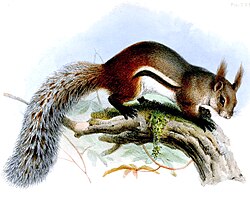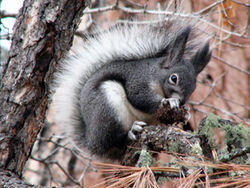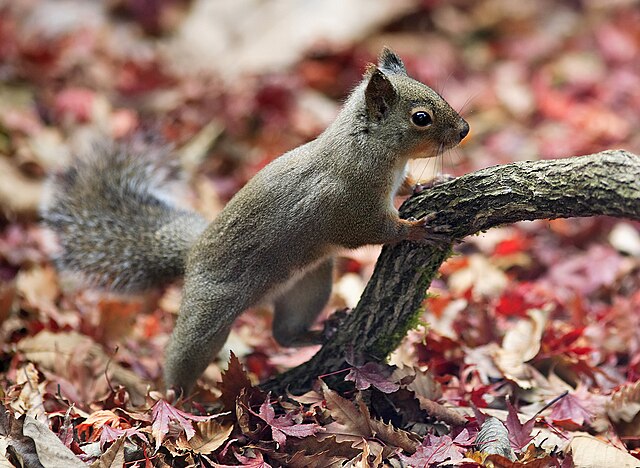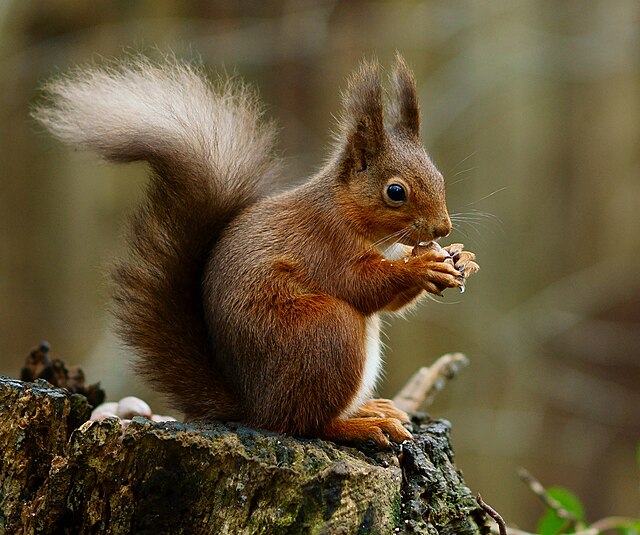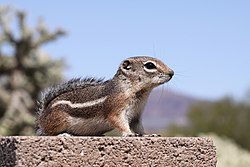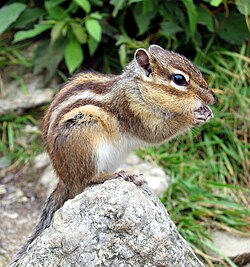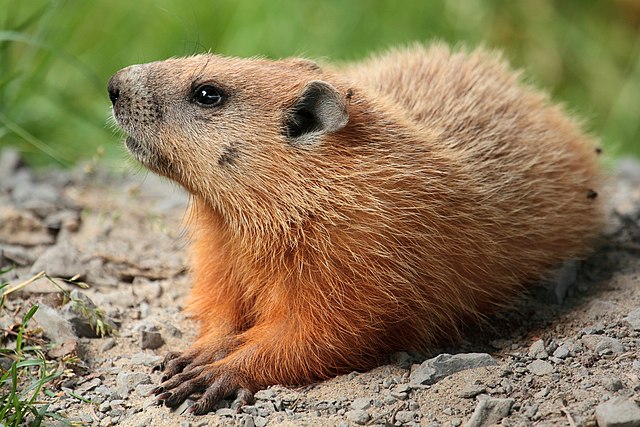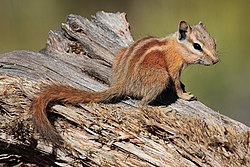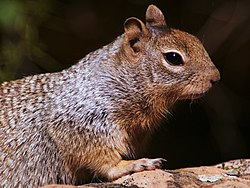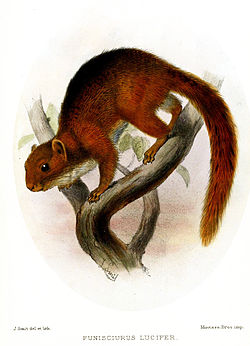Top Qs
Timeline
Chat
Perspective
List of sciurids
Species in mammal family Sciuridae From Wikipedia, the free encyclopedia
Remove ads
Sciuridae is a family of small mammals in the order Rodentia and part of the Sciuromorpha suborder.[1] Members of this family are called sciurids, and include squirrels, chipmunks, and marmots. They are found worldwide outside of Australia and Antarctica, primarily in forests, shrublands, and grasslands, though some species can be found in wetlands, deserts, or rocky areas. They range in size from the lesser pygmy flying squirrel, at 6 cm (2 in) plus a 6 cm (2 in) tail, to the Olympic marmot, at 75 cm (30 in) plus a 24 cm (9 in) tail. Sciurids primarily feed on fruit, seeds, and nuts, though many species also eat insects, fungi, bark, eggs, and small vertebrates. Almost no sciurids have population estimates, though fifteen species are categorized as endangered species and three—the Namdapha flying squirrel, Vancouver Island marmot, and speckled ground squirrel—are categorized as critically endangered.

The 284 extant species of Sciuridae are divided into five subfamilies: Callosciurinae, containing 67 species of Asian squirrels in 14 genera; Ratufinae, containing four species of giant squirrels in a single genus; Sciurillinae, containing only the neotropical pygmy squirrel; Sciurinae, containing 84 species of flying squirrel and tree squirrels in 20 genera; and Xerinae, containing 128 species of marmots, chipmunks, prairie dogs, and ground squirrels in 24 genera. A few extinct prehistoric sciurid species have been discovered, though due to ongoing research and discoveries, the exact number and categorization is not fixed.[2]
Remove ads
Conventions
Quick facts Conservation status, EX ...
| Conservation status | |
|---|---|
| EX | Extinct (0 species) |
| EW | Extinct in the wild (0 species) |
| CR | Critically endangered (3 species) |
| EN | Endangered (15 species) |
| VU | Vulnerable (14 species) |
| NT | Near threatened (24 species) |
| LC | Least concern (196 species) |
| Other categories | |
| DD | Data deficient (32 species) |
| NE | Not evaluated (0 species) |
Close
The author citation for the species or genus is given after the scientific name; parentheses around the author citation indicate that this was not the original taxonomic placement. Conservation status codes listed follow the International Union for Conservation of Nature (IUCN) Red List of Threatened Species. Range maps are provided wherever possible; if a range map is not available, a description of the sciurid's range is provided. Ranges are based on the IUCN Red List for that species unless otherwise noted.
Remove ads
Classification
Summarize
Perspective
Sciuridae is a family consisting of 284 species in 60 genera. These genera are divided between five subfamilies: Callosciurinae, Ratufinae, Sciurillinae, Sciurinae, and Xerinae. Callosciurinae contains 67 species in 14 genera, Ratufinae contains four species in a single genus, Sciurillinae contains a single species, Sciurinae contains 84 species in 20 genera, and Xerinae contains 128 species in 24 genera.
Family Sciuridae
- Subfamily Callosciurinae
- Genus Callosciurus (beautiful squirrels): fifteen species
- Genus Dremomys (red-cheeked squirrels): six species
- Genus Exilisciurus (pygmy squirrels): three species
- Genus Funambulus (palm squirrels): six species
- Genus Glyphotes (sculptor squirrel): one species
- Genus Hyosciurus (long-nosed squirrels): two species
- Genus Lariscus (black-striped squirrels): four species
- Genus Menetes (Berdmore's ground squirrel): one species
- Genus Nannosciurus (black-eared squirrel): one species
- Genus Prosciurillus (Sulawesi tree squirrels): seven species
- Genus Rhinosciurus (shrew-faced squirrel): one species
- Genus Rubrisciurus (red-bellied squirrel): one species
- Genus Sundasciurus (Sunda squirrels): fifteen species
- Genus Tamiops (Asiatic striped squirrels): four species
- Subfamily Ratufinae
- Genus Ratufa (giant squirrels): four species
- Subfamily Sciurillinae
- Genus Sciurillus (neotropical pygmy squirrel): one species
- Subfamily Sciurinae
- Genus Aeretes (groove-toothed flying squirrel): one species
- Genus Aeromys (large black flying squirrels): two species
- Genus Belomys (hairy-footed flying squirrel): one species
- Genus Biswamoyopterus (Indochinese giant flying squirrels): two species
- Genus Eoglaucomys (Kashmir flying squirrel): one species
- Genus Eupetaurus (western woolly flying squirrel): one species
- Genus Glaucomys (New World flying squirrels): two species
- Genus Hylopetes (arrow-tailed flying squirrels): nine species
- Genus Iomys (Horsfield's flying squirrels (Iomys)s): two species
- Genus Microsciurus (dwarf squirrels): four species
- Genus Petaurillus (pygmy flying squirrels): three species
- Genus Petaurista (giant flying squirrels): ten species
- Genus Petinomys (dwarf flying squirrels): eight species
- Genus Pteromys (Old World flying squirrels): two species
- Genus Pteromyscus (smoky flying squirrel): one species
- Genus Rheithrosciurus (tufted ground squirrel): one species
- Genus Sciurus (tree squirrels): twenty-nine species
- Genus Syntheosciurus (Bangs's mountain squirrel): one species
- Genus Tamiasciurus (American pine squirrels): three species
- Genus Trogopterus (complex-toothed flying squirrel): one species
- Subfamily Xerinae
- Genus Ammospermophilus (antelope squirrels): four species
- Genus Atlantoxerus (Barbary ground squirrel): one species
- Genus Callospermophilus (golden-mantled ground squirrels): three species
- Genus Cynomys (prairie dogs): five species
- Genus Epixerus (Ebian's palm squirrel): one species
- Genus Eutamias (Siberian chipmunk): one species
- Genus Funisciurus (rope squirrels): ten species
- Genus Heliosciurus (sun squirrels): six species
- Genus Ictidomys (lined ground squirrels): two species
- Genus Marmota (marmots): fourteen species
- Genus Myosciurus (African pygmy squirrel): one species
- Genus Neotamias (chipmunks): twenty-three species
- Genus Notocitellus (tropical ground squirrels): two species
- Genus Otospermophilus (American rock squirrels): two species
- Genus Paraxerus (African bush squirrels): eleven species
- Genus Poliocitellus (Franklin's ground squirrel): one species
- Genus Protoxerus (African giant squirrels): two species
- Genus Sciurotamias (Chinese rock squirrels): two species
- Genus Spermophilopsis (long-clawed ground squirrel): one species
- Genus Spermophilus (Holarctic ground squirrels): fifteen species
- Genus Tamias (eastern chipmunk): one species
- Genus Urocitellus (ground squirrels): twelve species
- Genus Xerospermophilus (desert ground squirrels): four species
- Genus Xerus (unstriped ground squirrels): four species
Remove ads
Sciurids
Summarize
Perspective
The following classification is based on the taxonomy described by the reference work Mammal Species of the World (2005), with augmentation by generally accepted proposals made since using molecular phylogenetic analysis, as supported by both the IUCN and the American Society of Mammalogists.[1]
Subfamily Callosciurinae
Main article: Callosciurinae
More information Common name, Scientific name and subspecies ...
| Common name | Scientific name and subspecies | Range | Size and ecology | IUCN status and estimated population |
|---|---|---|---|---|
| Anderson's squirrel | C. quinquestriatus (Anderson, 1871) Two subspecies
|
Southern China and Myanmar |
Size: About 20 cm (8 in) long, plus 18–21 cm (7–8 in) tail[3] Habitat: Forest[4] Diet: Fruit, nuts, seeds, flowers, vegetation, insects, and eggs[5] |
LC
|
| Black-striped squirrel | C. nigrovittatus (Horsfield, 1823) Four subspecies
|
Southeastern Asia |
Size: 18–20 cm (7–8 in) long, plus 15–19 cm (6–7 in) tail[3] Habitat: Forest and shrubland[6] Diet: Fruit, nuts, seeds, flowers, vegetation, insects, and eggs[5] |
LC
|
| Borneo black-banded squirrel | C. orestes (Thomas, 1895) |
Northern Borneo |
Size: 14–16 cm (6 in) long, plus 13–16 cm (5–6 in) tail[3] Habitat: Forest[7] Diet: Fruit, nuts, seeds, flowers, vegetation, insects, and eggs[5] |
LC
|
| Ear-spot squirrel | C. adamsi (Kloss, 1921) |
Borneo | Size: 15–17 cm (6–7 in) long, plus 14–16 cm (6 in) tail[3] Habitat: Forest[8] Diet: Fruit, nuts, seeds, flowers, vegetation, insects, and eggs[5] |
NT
|
| Finlayson's squirrel | C. finlaysonii (Horsfield, 1823) Sixteen subspecies
|
Southeastern Asia |
Size: 19–21 cm (7–8 in) long, plus 17–22 cm (7–9 in) tail[3] Habitat: Forest, shrubland, and inland wetlands[9] Diet: Fruit, nuts, seeds, flowers, vegetation, insects, and eggs[5] |
LC
|
| Grey-bellied squirrel | C. caniceps (Gray, 1842) Six subspecies
|
Southeastern Asia |
Size: 21–22 cm (8–9 in) long, plus 22–24 cm (9 in) tail[3] Habitat: Forest and shrubland[10] Diet: Fruit, nuts, seeds, flowers, vegetation, insects, and eggs[5] |
LC
|
| Inornate squirrel | C. inornatus (Gray, 1867) |
Southeastern Asia | Size: About 29 cm (11 in) long, plus 17–21 cm (7–8 in) tail[3] Habitat: Forest and shrubland[11] Diet: Fruit, nuts, seeds, flowers, vegetation, insects, and eggs[5] |
LC
|
| Irrawaddy squirrel | C. pygerythrus (Geoffroy, 1831) Seven subspecies
|
Southern Asia |
Size: 18–23 cm (7–9 in) long, plus 11–22 cm (4–9 in) tail[3] Habitat: Shrubland and forest[12] Diet: Fruit, nuts, seeds, flowers, vegetation, insects, and eggs[5] |
LC
|
| Kinabalu squirrel
|
C. baluensis (Bonhote, 1901) |
Malaysia | Size: 23–24 cm (9 in) long, plus 24–25 cm (9–10 in) tail[3] Habitat: Forest[13] Diet: Fruit, nuts, seeds, flowers, vegetation, insects, and eggs[5] |
LC
|
| Kloss's squirrel
|
C. albescens (Bonhote, 1901) |
Indonesia | Size: 20–24 cm (8–9 in) long, plus 17–19 cm (7 in) tail[3] Habitat: Forest and shrubland[14] Diet: Fruit, nuts, seeds, flowers, vegetation, insects, and eggs[5] |
DD
|
| Mentawai squirrel | C. melanogaster (Thomas, 1895) Three subspecies
|
Indonesia | Size: About 21 cm (8 in) long, plus about 18 cm (7 in) tail[3] Habitat: Forest[15] Diet: Fruit, nuts, seeds, flowers, vegetation, insects, and eggs[5] |
VU
|
| Pallas's squirrel | C. erythraeus (Pallas, 1779) 26 subspecies
|
Southeastern and eastern Asia |
Size: 21–23 cm (8–9 in) long, plus 17–27 cm (7–11 in) tail[3] Habitat: Forest and shrubland[16] Diet: Fruit, nuts, seeds, flowers, vegetation, insects, and eggs[5] |
LC
|
| Phayre's squirrel | C. phayrei (Blyth, 1856) |
Southern China and Myanmar |
Size: 21–24 cm (8–9 in) long, plus 20–25 cm (8–10 in) tail[3] Habitat: Forest[17] Diet: Fruit, nuts, seeds, flowers, vegetation, insects, and eggs[5] |
LC
|
| Plantain squirrel | C. notatus (Boddaert, 1785) Five subspecies
|
Southeastern Asia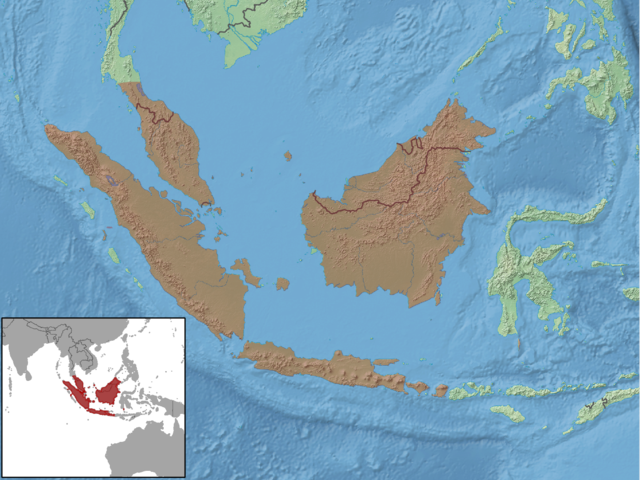 |
Size: 20–24 cm (8–9 in) long, plus 17–19 cm (7 in) tail[3] Habitat: Forest, shrubland, and inland wetlands[18] Diet: Fruit, nuts, seeds, flowers, vegetation, insects, and eggs[5] |
LC
|
| Prevost's squirrel | C. prevostii (Desmarest, 1822) Six subspecies
|
Southeastern Asia |
Size: About 24 cm (9 in) long, plus about 23 cm (9 in) tail[3] Habitat: Forest[19] Diet: Fruit, nuts, seeds, flowers, vegetation, insects, and eggs[5][19] |
LC
|
Close
More information Common name, Scientific name and subspecies ...
| Common name | Scientific name and subspecies | Range | Size and ecology | IUCN status and estimated population |
|---|---|---|---|---|
| Asian red-cheeked squirrel | D. rufigenis (Blanford, 1878) Five subspecies
|
Southeastern and eastern Asia |
Size: 18–20 cm (7–8 in) long, plus 14–17 cm (6–7 in) tail[20] Habitat: Forest and shrubland[21] Diet: Fruit, nuts, vegetation, and insects[22] |
LC
|
| Bornean mountain ground squirrel | D. everetti (Thomas, 1890) |
Borneo | Size: 15–18 cm (6–7 in) long, plus 9–12 cm (4–5 in) tail[23] Habitat: Forest[24] Diet: Fruit, nuts, vegetation, and insects[22] |
LC
|
| Orange-bellied Himalayan squirrel | D. lokriah (Hodgson, 1836) Five subspecies
|
Southern Asia |
Size: 16–20 cm (6–8 in) long, plus 13–22 cm (5–9 in) tail[20] Habitat: Forest[25] Diet: Fruit, nuts, vegetation, and insects[22] |
LC
|
| Perny's long-nosed squirrel | D. pernyi (H. Milne-Edwards, 1867) Six subspecies
|
Eastern Asia |
Size: 17–20 cm (7–8 in) long, plus 13–18 cm (5–7 in) tail[20] Habitat: Forest[26] Diet: Fruit, nuts, vegetation, and insects[22] |
LC
|
| Red-hipped squirrel | D. pyrrhomerus (Thomas, 1895) Two subspecies
|
China and Vietnam | Size: 19–21 cm (7–8 in) long, plus 14–17 cm (6–7 in) tail[20] Habitat: Rocky areas[27] Diet: Fruit, nuts, vegetation, and insects[22] |
LC
|
| Red-throated squirrel
|
D. gularis Osgood, 1932 |
China and Vietnam | Size: About 22 cm (9 in) long, plus about 17 cm (7 in) tail[20] Habitat: Forest[28] Diet: Fruit, nuts, vegetation, and insects[22] |
DD
|
Close
More information Common name, Scientific name and subspecies ...
| Common name | Scientific name and subspecies | Range | Size and ecology | IUCN status and estimated population |
|---|---|---|---|---|
| Least pygmy squirrel | E. exilis (Müller, 1838) |
Southeastern Asia | Size: 7–8 cm (3 in) long, plus 4–6 cm (2 in) tail[20] Habitat: Forest[29] Diet: Vegetation and insects[22] |
DD
|
| Philippine pygmy squirrel
|
E. concinnus (Thomas, 1888) |
Philippines |
Size: About 9 cm (4 in) long, plus 6–7 cm (2–3 in) tail[20] Habitat: Forest[30] Diet: Vegetation and insects[22] |
LC
|
| Tufted pygmy squirrel | E. whiteheadi (Thomas, 1887) |
Borneo | Size: 8–9 cm (3–4 in) long, plus 6–7 cm (2–3 in) tail[20] Habitat: Forest[31] Diet: Vegetation and insects[22] |
LC
|
Close
More information Common name, Scientific name and subspecies ...
| Common name | Scientific name and subspecies | Range | Size and ecology | IUCN status and estimated population |
|---|---|---|---|---|
| Dusky striped squirrel | F. obscurus (Pelzeln & Kohl, 1886) |
Sri Lanka | Size: 10–14 cm (4–6 in) long, plus 7–13 cm (3–5 in) tail[20] Habitat: Forest[32] Diet: Seeds, nuts, bark, buds, leaves, flowers, and insects[33] |
VU
|
| Indian palm squirrel | F. palmarum (Linnaeus, 1766) Three subspecies
|
India and Sri Lanka | Size: 14–15 cm (6 in) long, plus 14–16 cm (6 in) tail[20] Habitat: Forest, shrubland, grassland, and inland wetlands[34] Diet: Seeds, nuts, bark, buds, leaves, flowers, and insects[33] |
LC
|
| Jungle palm squirrel | F. tristriatus (Waterhouse, 1837) Two subspecies
|
India | Size: 15–16 cm (6 in) long, plus 13–15 cm (5–6 in) tail[20] Habitat: Forest[35] Diet: Seeds, nuts, bark, buds, leaves, flowers, and insects[33] |
LC
|
| Layard's palm squirrel | F. layardi (Blyth, 1849) Two subspecies
|
Sri Lanka | Size: 14–16 cm (6 in) long, plus 15–17 cm (6–7 in) tail[20] Habitat: Forest[36] Diet: Seeds, nuts, bark, buds, leaves, flowers, and insects[33] |
VU
|
| Nilgiri striped squirrel | F. sublineatus (Waterhouse, 1838) Two subspecies
|
India | Size: 11–13 cm (4–5 in) long, plus 9–14 cm (4–6 in) tail[20] Habitat: Forest[37] Diet: Seeds, nuts, bark, buds, leaves, flowers, and insects[33] |
VU
|
| Northern palm squirrel | F. pennantii Wroughton, 1905 Two subspecies
|
Southern Asia | Size: 13–16 cm (5–6 in) long, plus 13–14 cm (5–6 in) tail[20] Habitat: Forest, shrubland, and grassland[38] Diet: Seeds, nuts, bark, buds, leaves, flowers, and insects[33] |
LC
|
Close
More information Common name, Scientific name and subspecies ...
| Common name | Scientific name and subspecies | Range | Size and ecology | IUCN status and estimated population |
|---|---|---|---|---|
| Sculptor squirrel | G. simus Thomas, 1898 |
Borneo | Size: 9–15 cm (4–6 in) long, plus 9–11 cm (4 in) tail[3] Habitat: Forest[39] Diet: Fruit, nuts, seeds, flowers, vegetation, insects, and eggs[22] |
DD
|
Close
More information Common name, Scientific name and subspecies ...
| Common name | Scientific name and subspecies | Range | Size and ecology | IUCN status and estimated population |
|---|---|---|---|---|
| Lowland long-nosed squirrel
|
H. ileile Archbold & Tate, 1936 |
Indonesia | Size: 21–25 cm (8–10 in) long, plus 7–13 cm (3–5 in) tail[23] Habitat: Forest and shrubland[40] Diet: Fruit, nuts, and insects[41] |
LC
|
| Montane long-nosed squirrel
|
H. heinrichi Archbold & Tate, 1935 |
Indonesia | Size: 19–24 cm (7–9 in) long, plus 6–12 cm (2–5 in) tail[23] Habitat: Forest[42] Diet: Fruit, nuts, and insects[41] |
LC
|
Close
More information Common name, Scientific name and subspecies ...
| Common name | Scientific name and subspecies | Range | Size and ecology | IUCN status and estimated population |
|---|---|---|---|---|
| Four-striped ground squirrel
|
L. hosei (Thomas, 1892) |
Borneo | Size: About 19 cm (7 in) long, plus about 9 cm (4 in) tail[3] Habitat: Forest[43] Diet: Fruit and nuts[44] |
LC
|
| Mentawai three-striped squirrel | L. obscurus (Miller, 1903) Three subspecies
|
Indonesia | Size: About 20 cm (8 in) long, plus 8–9 cm (3–4 in) tail[3] Habitat: Forest and shrubland[45] Diet: Fruit and nuts[44] |
NT
|
| Niobe ground squirrel
|
L. niobe (Thomas, 1892) Two subspecies
|
Indonesia | Size: 18–20 cm (7–8 in) long, plus 8–9 cm (3–4 in) tail[3] Habitat: Forest and shrubland[46] Diet: Fruit and nuts[44] |
DD
|
| Three-striped ground squirrel | L. insignis (F. Cuvier, 1821) Five subspecies
|
Southeastern Asia |
Size: 18–20 cm (7–8 in) long, plus 10–11 cm (4 in) tail[3] Habitat: Forest[47] Diet: Fruit and nuts[44] |
LC
|
Close
More information Common name, Scientific name and subspecies ...
| Common name | Scientific name and subspecies | Range | Size and ecology | IUCN status and estimated population |
|---|---|---|---|---|
| Berdmore's ground squirrel | M. berdmorei (Blyth, 1849) Seven subspecies
|
Southeastern Asia |
Size: About 18 cm (7 in) long, plus 13–14 cm (5–6 in) tail[23] Habitat: Grassland, shrubland, and forest[48] Diet: Fruit and nuts[49] |
LC
|
Close
More information Common name, Scientific name and subspecies ...
| Common name | Scientific name and subspecies | Range | Size and ecology | IUCN status and estimated population |
|---|---|---|---|---|
| Black-eared squirrel | N. melanotis (Müller, 1840) Four subspecies
|
Southeastern Asia | Size: About 8 cm (3 in) long, plus 6–7 cm (2–3 in) tail[23] Habitat: Forest[50] Diet: Fruit and nuts[22] |
LC
|
Close
More information Common name, Scientific name and subspecies ...
| Common name | Scientific name and subspecies | Range | Size and ecology | IUCN status and estimated population |
|---|---|---|---|---|
| Alston's squirrel
|
P. alstoni Anderson, 1879 |
Indonesia | Size: 15–20 cm (6–8 in) long, plus 13–18 cm (5–7 in) tail[20] Habitat: Forest[51] Diet: Fruit, nuts, bark, and resin[52] |
NT
|
| Mount Topapu squirrel
|
P. topapuensis Roux, 1910 |
Indonesia | Size: 15–19 cm (6–7 in) long, plus 12–17 cm (5–7 in) tail[20] Habitat: Forest[53] Diet: Fruit, nuts, bark, and resin[52] |
NT
|
| Celebes dwarf squirrel | P. murinus (Müller & Schlegel, 1844) Three subspecies
|
Indonesia | Size: 10–15 cm (4–6 in) long, plus 5–12 cm (2–5 in) tail[23] Habitat: Forest[54] Diet: Fruit, nuts, bark, and resin[52] |
LC
|
| Sanghir squirrel | P. rosenbergii (Jentink, 1879) |
Indonesia and Philippines | Size: About 19 cm (7 in) long, plus about 18 cm (7 in) tail[23] Habitat: Forest[55] Diet: Fruit, nuts, bark, and resin[52] |
EN
|
| Secretive dwarf squirrel
|
P. abstrusus Moore, 1958 |
Indonesia | Size: 11–15 cm (4–6 in) long, plus 7–13 cm (3–5 in) tail[23] Habitat: Forest[56] Diet: Fruit, nuts, bark, and resin[52] |
NT
|
| Weber's dwarf squirrel
|
P. weberi (Jentink, 1890) |
Indonesia | Size: About 19 cm (7 in) long, plus about 14 cm (6 in) tail[20] Habitat: Forest[57] Diet: Fruit, nuts, bark, and resin[52] |
VU
|
| Whitish dwarf squirrel | P. leucomus (Müller & Schlegel, 1844) Four subspecies
|
Indonesia | Size: 16–19 cm (6–7 in) long, plus 14–19 cm (6–7 in) tail[20] Habitat: Forest[58] Diet: Fruit, nuts, bark, and resin[52] |
LC
|
Close
More information Common name, Scientific name and subspecies ...
| Common name | Scientific name and subspecies | Range | Size and ecology | IUCN status and estimated population |
|---|---|---|---|---|
| Shrew-faced squirrel | R. laticaudatus (Müller, 1840) Three subspecies
|
Southeastern Asia |
Size: 19–21 cm (7–8 in) long, plus 11–14 cm (4–6 in) tail[23] Habitat: Forest[59] Diet: Insects and earthworms, as well as fruit[44] |
NT
|
Close
More information Common name, Scientific name and subspecies ...
| Common name | Scientific name and subspecies | Range | Size and ecology | IUCN status and estimated population |
|---|---|---|---|---|
| Red-bellied squirrel
|
R. rubriventer (Müller & Schlegel, 1844) |
Island of Sulawesi in Indonesia | Size: 15–30 cm (6–12 in) long, plus 18–25 cm (7–10 in) tail[20] Habitat: Forest[60] Diet: Fruit and seeds[61] |
LC
|
Close
More information Common name, Scientific name and subspecies ...
| Common name | Scientific name and subspecies | Range | Size and ecology | IUCN status and estimated population |
|---|---|---|---|---|
| Brooke's squirrel
|
S. brookei (Thomas, 1892) |
Indonesia and Malaysia | Size: 15–16 cm (6 in) long, plus 11–13 cm (4–5 in) tail[23] Habitat: Forest[62] Diet: Fruit and vegetation, as well as insects[49] |
LC
|
| Busuanga squirrel
|
S. hoogstraali (Sanborn, 1952) |
Philippines |
Size: About 20 cm (8 in) long, plus 16–17 cm (6–7 in) tail[23] Habitat: Forest[63] Diet: Fruit and vegetation, as well as insects[49] |
LC
|
| Culion tree squirrel
|
S. moellendorffi (Matschie, 1898) |
Philippines |
Size: About 20 cm (8 in) long, plus about 19 cm (7 in) tail[23] Habitat: Forest[64] Diet: Fruit and vegetation, as well as insects[49] |
NT
|
| Davao squirrel
|
S. davensis (Sanborn, 1952) |
Philippines |
Size: About 20 cm (8 in) long, plus about 18 cm (7 in) tail[23] Habitat: Forest[65] Diet: Fruit and vegetation, as well as insects[49] |
DD
|
| Fraternal squirrel
|
S. fraterculus (Thomas, 1895) |
Indonesia | Size: 11–12 cm (4–5 in) long, plus 7–8 cm (3 in) tail[23] Habitat: Forest[66] Diet: Fruit and vegetation, as well as insects[49] |
VU
|
| Horse-tailed squirrel | S. hippurus (Geoffroy, 1831) Five subspecies
|
Southeastern Asia |
Size: 23–25 cm (9–10 in) long, plus 23–25 cm (9–10 in) tail[23] Habitat: Forest[67] Diet: Fruit and vegetation, as well as insects[49] |
NT
|
| Jentink's squirrel
|
S. jentinki (Thomas, 1887) |
Indonesia and Malaysia | Size: 12–13 cm (5 in) long, plus 11–13 cm (4–5 in) tail[23] Habitat: Forest[68] Diet: Fruit and vegetation, as well as insects[49] |
LC
|
| Low's squirrel | S. lowii (Thomas, 1892) Seven subspecies
|
Southeastern Asia |
Size: 12–17 cm (5–7 in) long, plus 7–11 cm (3–4 in) tail[23] Habitat: Forest[69] Diet: Fruit and vegetation, as well as insects[49] |
LC
|
| Mindanao squirrel | S. mindanensis (Steere, 1890) |
Philippines |
Size: About 20 cm (8 in) long, plus about 19 cm (7 in) tail[23] Habitat: Forest[70] Diet: Fruit and vegetation, as well as insects[49] |
LC
|
| Northern Palawan tree squirrel
|
S. juvencus (Thomas, 1908) |
Philippines |
Size: 19–20 cm (7–8 in) long, plus 15–18 cm (6–7 in) tail[23] Habitat: Forest[71] Diet: Fruit and vegetation, as well as insects[49] |
LC
|
| Palawan montane squirrel
|
S. rabori Heaney, 1979 |
Philippines |
Size: 16–19 cm (6–7 in) long, plus 13–14 cm (5–6 in) tail[23] Habitat: Forest[72] Diet: Fruit and vegetation, as well as insects[49] |
DD
|
| Philippine tree squirrel
|
S. philippinensis (Waterhouse, 1839) |
Philippines |
Size: About 19 cm (7 in) long, plus 17–20 cm (7–8 in) tail[23] Habitat: Forest[73] Diet: Fruit and vegetation, as well as insects[49] |
LC
|
| Samar squirrel | S. samarensis (Steere, 1890) |
Philippines |
Size: 18–20 cm (7–8 in) long, plus 15–17 cm (6–7 in) tail[23] Habitat: Forest[74] Diet: Fruit and vegetation, as well as insects[49] |
LC
|
| Slender squirrel | S. tenuis (Horsfield, 1824) Five subspecies
|
Southeastern Asia |
Size: About 14 cm (6 in) long, plus 11–12 cm (4–5 in) tail[23] Habitat: Forest[75] Diet: Fruit and vegetation, as well as insects[49] |
LC
|
| Southern Palawan tree squirrel | S. steerii (Günther, 1877) |
Philippines |
Size: About 20 cm (8 in) long, plus about 16 cm (6 in) tail[23] Habitat: Forest[76] Diet: Fruit and vegetation, as well as insects[49] |
LC
|
Close
More information Common name, Scientific name and subspecies ...
| Common name | Scientific name and subspecies | Range | Size and ecology | IUCN status and estimated population |
|---|---|---|---|---|
| Cambodian striped squirrel | T. rodolphii (H. Milne-Edwards, 1867) Two subspecies
|
Southeastern Asia |
Size: 11–12 cm (4–5 in) long, plus 10–12 cm (4–5 in) tail[20] Habitat: Forest and shrubland[77] Diet: Fruit, nuts, seeds, and insects[49] |
LC
|
| Himalayan striped squirrel | T. mcclellandii (Horsfield, 1840) Six subspecies
|
Southeastern Asia |
Size: 11–12 cm (4–5 in) long, plus 10–11 cm (4 in) tail[20] Habitat: Forest, shrubland, grassland, and inland wetlands[78] Diet: Fruit, nuts, seeds, and insects[49] |
LC
|
| Maritime striped squirrel | T. maritimus (Bonhote, 1900) Four subspecies
|
Southeastern and eastern Asia |
Size: 11–13 cm (4–5 in) long, plus 10–11 cm (4 in) tail[20] Habitat: Forest and shrubland[79] Diet: Fruit, nuts, seeds, and insects[49] |
LC
|
| Swinhoe's striped squirrel | T. swinhoei (H. Milne-Edwards, 1874) Four subspecies
|
China and southeastern Asia |
Size: About 13 cm (5 in) long, plus about 10 cm (4 in) tail[20] Habitat: Forest and shrubland[80] Diet: Fruit, nuts, seeds, and insects[49] |
LC
|
Close
Subfamily Ratufinae
Main article: Ratufinae
More information Common name, Scientific name and subspecies ...
| Common name | Scientific name and subspecies | Range | Size and ecology | IUCN status and estimated population |
|---|---|---|---|---|
| Black giant squirrel | R. bicolor (Sparrman, 1778) Ten subspecies
|
Southeastern Asia |
Size: 33–36 cm (13–14 in) long, plus 41–42 cm (16–17 in) tail[81] Habitat: Forest[82] Diet: Fruit, nuts, bark, insects, and eggs[33] |
NT
|
| Cream-coloured giant squirrel | R. affinis (Raffles, 1821) Nine subspecies
|
Southeastern Asia |
Size: 33–34 cm (13 in) long, plus 41–42 cm (16–17 in) tail[81] Habitat: Forest[83] Diet: Fruit, nuts, bark, insects, and eggs[33] |
NT
|
| Grizzled giant squirrel | R. macroura (Pennant, 1769) Three subspecies
|
Southern India and Sri Lanka |
Size: 32–40 cm (13–16 in) long, plus 35–36 cm (14 in) tail[81] Habitat: Forest[84] Diet: Fruit, nuts, bark, insects, and eggs[33] |
NT
|
| Indian giant squirrel | R. indica (Erxleben, 1777) Four subspecies
|
India |
Size: 34–45 cm (13–18 in) long, plus 38–49 cm (15–19 in) tail[81] Habitat: Forest[85] Diet: Fruit, nuts, bark, insects, and eggs[33] |
LC
|
Close
Subfamily Sciurillinae
Main article: Sciurillinae
More information Common name, Scientific name and subspecies ...
| Common name | Scientific name and subspecies | Range | Size and ecology | IUCN status and estimated population |
|---|---|---|---|---|
| Neotropical pygmy squirrel | S. pusillus (Geoffroy, 1803) Three subspecies
|
Northern South America |
Size: 8–12 cm (3–5 in) long, plus 8–12 cm (3–5 in) tail[81] Habitat: Forest[86] Diet: Fruit, nuts, bark, and resin[52] |
LC
|
Close
Subfamily Sciurinae
Main article: Sciurinae
More information Common name, Scientific name and subspecies ...
| Common name | Scientific name and subspecies | Range | Size and ecology | IUCN status and estimated population |
|---|---|---|---|---|
| Groove-toothed flying squirrel | A. melanopterus (H. Milne-Edwards, 1867) Two subspecies
|
Central China | Size: 27–35 cm (11–14 in) long, plus 27–36 cm (11–14 in) tail[87] Habitat: Forest[88] Diet: Nuts, fruit, twigs, shoots, leaves, bark and insects[89] |
LC
|
Close
More information Common name, Scientific name and subspecies ...
| Common name | Scientific name and subspecies | Range | Size and ecology | IUCN status and estimated population |
|---|---|---|---|---|
| Black flying squirrel | A. tephromelas (Günther, 1873) Two subspecies
|
Southeastern Asia |
Size: 37–38 cm (15 in) long, plus 39–44 cm (15–17 in) tail[90] Habitat: Forest[91] Diet: Fruit, nuts, leaves, and insects[92] |
DD
|
| Thomas's flying squirrel
|
A. thomasi (Hose, 1900) |
Indonesia and Malaysia | Size: 30–36 cm (12–14 in) long, plus 37–41 cm (15–16 in) tail[90] Habitat: Forest[93] Diet: Fruit, nuts, leaves, and insects[92] |
LC
|
Close
More information Common name, Scientific name and subspecies ...
| Common name | Scientific name and subspecies | Range | Size and ecology | IUCN status and estimated population |
|---|---|---|---|---|
| Hairy-footed flying squirrel | B. pearsonii (Gray, 1842) Two subspecies
|
Southeastern and eastern Asia |
Size: 18–21 cm (7–8 in) long, plus 13–17 cm (5–7 in) tail[87] Habitat: Forest[94] Diet: Nuts, fruit, twigs, shoots, leaves, bark and insects[89] |
LC
|
Close
More information Common name, Scientific name and subspecies ...
| Common name | Scientific name and subspecies | Range | Size and ecology | IUCN status and estimated population |
|---|---|---|---|---|
| Laotian giant flying squirrel | B. laoensis Sanamxay, Douangboubpha, Bumrungsri, Xayavong, Xayaphet, Satasook, & Bates, 2013 |
Laos |
Size: About 46 cm (18 in) long, plus about 62 cm (24 in) tail[87] Habitat: Forest[95] Diet: Unknown[92] |
DD
|
| Namdapha flying squirrel | B. biswasi Saha, 1981 |
Eastern India | Size: About 40 cm (16 in) long, plus about 60 cm (24 in) tail[87] Habitat: Forest[96] Diet: Unknown[92] |
CR
|
Close
More information Common name, Scientific name and subspecies ...
| Common name | Scientific name and subspecies | Range | Size and ecology | IUCN status and estimated population |
|---|---|---|---|---|
| Kashmir flying squirrel
|
E. fimbriatus (Gray, 1837) Two subspecies
|
Central Asia | Size: 23–30 cm (9–12 in) long, plus 25–33 cm (10–13 in) tail[97] Habitat: Forest[98] Diet: Seeds, as well as shoots, buds, leaves, and nuts[99] |
LC
|
Close
More information Common name, Scientific name and subspecies ...
| Common name | Scientific name and subspecies | Range | Size and ecology | IUCN status and estimated population |
|---|---|---|---|---|
| Western woolly flying squirrel | E. cinereus Thomas, 1888 |
Western China | Size: 42–61 cm (17–24 in) long, plus 38–54 cm (15–21 in) tail[87] Habitat: Forest, rocky areas, and caves[100] Diet: Moss and lichen[92] |
EN
|
Close
More information Common name, Scientific name and subspecies ...
| Common name | Scientific name and subspecies | Range | Size and ecology | IUCN status and estimated population |
|---|---|---|---|---|
| Northern flying squirrel | G. sabrinus (Shaw, 1801) 25 subspecies
|
Canada and northern United States |
Size: 11–19 cm (4–7 in) long, plus 12–16 cm (5–6 in) tail[97] Habitat: Forest[101] Diet: Nuts, bark, lichen, fungi, fruit, and berries, as well as insects[99] |
LC
|
| Southern flying squirrel | G. volans (Linnaeus, 1758) Eleven subspecies
|
Eastern North America |
Size: 11–14 cm (4–6 in) long, plus 8–12 cm (3–5 in) tail[97] Habitat: Forest[102] Diet: Nuts, bark, lichen, fungi, fruit, and berries, as well as insects[99] |
LC
|
Close
More information Common name, Scientific name and subspecies ...
| Common name | Scientific name and subspecies | Range | Size and ecology | IUCN status and estimated population |
|---|---|---|---|---|
| Arrow flying squirrel | H. sagitta (Linnaeus, 1766) |
Indonesia | Size: 11–13 cm (4–5 in) long, plus 9–13 cm (4–5 in) tail[90] Habitat: Forest[103] Diet: Nuts, shoots, leaves, fruit, insects, and small snakes[99] |
DD
|
| Bartel's flying squirrel
|
H. bartelsi Chasen, 1939 |
Indonesia | Size: 13–20 cm (5–8 in) long, plus 11–12 cm (4–5 in) tail[90] Habitat: Forest[104] Diet: Nuts, shoots, leaves, fruit, insects, and small snakes[99] |
DD
|
| Indochinese flying squirrel
|
H. phayrei (Blyth, 1859) Two subspecies
|
Southeastern Asia |
Size: 14–20 cm (6–8 in) long, plus 12–18 cm (5–7 in) tail[90] Habitat: Forest[105] Diet: Nuts, shoots, leaves, fruit, insects, and small snakes[99] |
LC
|
| Jentink's flying squirrel
|
H. platyurus Jentink, 1890 |
Southeastern Asia |
Size: 11–16 cm (4–6 in) long, plus 10–14 cm (4–6 in) tail[90] Habitat: Forest[106] Diet: Nuts, shoots, leaves, fruit, insects, and small snakes[99] |
DD
|
| Palawan flying squirrel | H. nigripes (Thomas, 1893) Two subspecies
|
Philippines |
Size: 25–33 cm (10–13 in) long, plus 25–31 cm (10–12 in) tail[90] Habitat: Forest[107] Diet: Nuts, shoots, leaves, fruit, insects, and small snakes[99] |
NT
|
| Particolored flying squirrel | H. alboniger (Hodgson, 1836) Three subspecies
|
Southeastern and eastern Asia |
Size: 17–25 cm (7–10 in) long, plus 18–23 cm (7–9 in) tail[90] Habitat: Forest and shrubland[108] Diet: Nuts, shoots, leaves, fruit, insects, and small snakes[99] |
LC
|
| Red-cheeked flying squirrel
|
H. spadiceus (Blyth, 1847) Two subspecies
|
Southeastern Asia |
Size: 13–19 cm (5–7 in) long, plus 10–17 cm (4–7 in) tail[90] Habitat: Forest and shrubland[109] Diet: Nuts, shoots, leaves, fruit, insects, and small snakes[99] |
LC
|
| Sipora flying squirrel
|
H. sipora Chasen, 1940 |
Indonesia | Size: About 14 cm (6 in) long, plus about 16 cm (6 in) tail[90] Habitat: Forest[110] Diet: Nuts, shoots, leaves, fruit, insects, and small snakes[99] |
EN
|
| Sumatran flying squirrel
|
H. winstoni (Sody, 1949) |
Indonesia | Size: About 14 cm (6 in) long, plus about 14 cm (6 in) tail[90] Habitat: Forest[111] Diet: Nuts, shoots, leaves, fruit, insects, and small snakes[99] |
DD
|
Close
More information Common name, Scientific name and subspecies ...
| Common name | Scientific name and subspecies | Range | Size and ecology | IUCN status and estimated population |
|---|---|---|---|---|
| Javanese flying squirrel | I. horsfieldii (Waterhouse, 1838) Four subspecies
|
Southeastern Asia | Size: 16–23 cm (6–9 in) long, plus 15–21 cm (6–8 in) tail[97] Habitat: Forest and shrubland[112] Diet: Nuts, fruit, twigs, shoots, leaves, bark and insects[89] |
LC
|
| Mentawi flying squirrel
|
I. sipora Chasen & Kloss, 1928 |
Indonesia | Size: 17–20 cm (7–8 in) long, plus 17–20 cm (7–8 in) tail[97] Habitat: Forest[113] Diet: Nuts, fruit, twigs, shoots, leaves, bark and insects[89] |
EN
|
Close
More information Common name, Scientific name and subspecies ...
| Common name | Scientific name and subspecies | Range | Size and ecology | IUCN status and estimated population |
|---|---|---|---|---|
| Amazon dwarf squirrel | M. flaviventer (Gray, 1867) Eight subspecies
|
Northwestern South America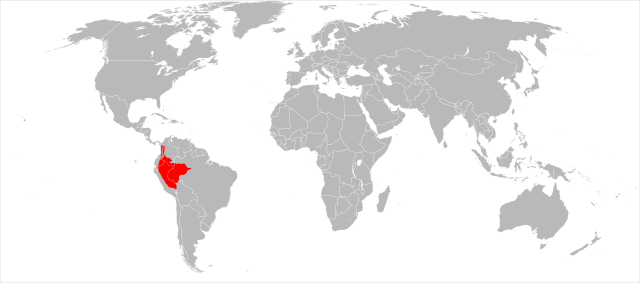 |
Size: 12–16 cm (5–6 in) long, plus 9–15 cm (4–6 in) tail[97] Habitat: Forest[114] Diet: Fruit and nuts[115] |
LC
|
| Central American dwarf squirrel | M. alfari (Allen, 1895) Six subspecies
|
Central America and northern South America |
Size: 10–15 cm (4–6 in) long, plus 8–13 cm (3–5 in) tail[97] Habitat: Forest[116] Diet: Fruit and nuts[115] |
LC
|
| Santander dwarf squirrel
|
M. santanderensis (Hernández-Camacho, 1957) |
Northern South America |
Size: 13–16 cm (5–6 in) long, plus 13–16 cm (5–6 in) tail[97] Habitat: Forest[117] Diet: Fruit and nuts[115] |
DD
|
| Western dwarf squirrel
|
M. mimulus (Thomas, 1898) Three subspecies
|
Central America and northern South America |
Size: 13–15 cm (5–6 in) long, plus 9–12 cm (4–5 in) tail[97] Habitat: Forest[118] Diet: Fruit and nuts[115] |
LC
|
Close
More information Common name, Scientific name and subspecies ...
| Common name | Scientific name and subspecies | Range | Size and ecology | IUCN status and estimated population |
|---|---|---|---|---|
| Hose's pygmy flying squirrel
|
P. hosei (Thomas, 1900) |
Island of Borneo | Size: 7–9 cm (3–4 in) long, plus 8–10 cm (3–4 in) tail[90] Habitat: Forest[119] Diet: Nuts, fruit, twigs, shoots, leaves, bark and insects[89] |
DD
|
| Lesser pygmy flying squirrel
|
P. emiliae Thomas, 1908 |
Borneo | Size: 6–8 cm (2–3 in) long, plus 6–7 cm (2–3 in) tail[90] Habitat: Forest[120] Diet: Nuts, fruit, twigs, shoots, leaves, bark and insects[89] |
DD
|
| Selangor pygmy flying squirrel
|
P. kinlochii (Chasen & Kloss, 1928) |
Malaysia | Size: 8–10 cm (3–4 in) long, plus 8–10 cm (3–4 in) tail[90] Habitat: Forest[121] Diet: Nuts, fruit, twigs, shoots, leaves, bark and insects[89] |
DD
|
Close
More information Common name, Scientific name and subspecies ...
| Common name | Scientific name and subspecies | Range | Size and ecology | IUCN status and estimated population |
|---|---|---|---|---|
| Bhutan giant flying squirrel | P. nobilis (Gray, 1842) Two subspecies
|
Bhutan and Nepal |
Size: 35–49 cm (14–19 in) long, plus 38–49 cm (15–19 in) tail[122] Habitat: Forest[123] Diet: Fruit, nuts, twigs, shoots, and leaves, as well as insects[124] |
NT
|
| Chinese giant flying squirrel
|
P. xanthotis (H. Milne-Edwards, 1872) |
Central China |
Size: 32–44 cm (13–17 in) long, plus 29–38 cm (11–15 in) tail[87] Habitat: Forest[125] Diet: Fruit, nuts, twigs, shoots, and leaves, as well as insects[124] |
LC
|
| Hodgson's giant flying squirrel | P. magnificus (Hodgson, 1836) |
Central Asia |
Size: 36–42 cm (14–17 in) long, plus 41–55 cm (16–22 in) tail[122] Habitat: Forest[126] Diet: Fruit, nuts, twigs, shoots, and leaves, as well as insects[124] |
LC
|
| Indian giant flying squirrel | P. philippensis (Elliot, 1839) Seven subspecies
|
Southern, eastern, and southeastern Asia |
Size: 38–61 cm (15–24 in) long, plus 48–69 cm (19–27 in) tail[122] Habitat: Forest[127] Diet: Fruit, nuts, twigs, shoots, and leaves, as well as insects[124] |
LC
|
| Japanese giant flying squirrel | P. leucogenys Temminck, 1827 Four subspecies
|
Japan |
Size: 27–48 cm (11–19 in) long, plus 28–41 cm (11–16 in) tail[87] Habitat: Forest[128] Diet: Fruit, nuts, twigs, shoots, and leaves, as well as insects[124] |
LC
|
| Mechuka giant flying squirrel
|
P. mechukaensis Choudhury, 2009 |
Northeastern India | Size: 46–53 cm (18–21 in) long, plus 52–77 cm (20–30 in) tail[122] Habitat: Forest[129] Diet: Fruit, nuts, twigs, shoots, and leaves, as well as insects[124] |
NT
|
| Mishmi giant flying squirrel | P. mishmiensis Choudhury, 2009 |
Northeastern India | Size: 40–59 cm (16–23 in) long, plus 57–60 cm (22–24 in) tail[122] Habitat: Forest[130] Diet: Fruit, nuts, twigs, shoots, and leaves, as well as insects[124] |
NT
|
| Red and white giant flying squirrel | P. alborufus (A. Milne-Edwards, 1870) Five subspecies
|
China and Taiwan |
Size: 35–58 cm (14–23 in) long, plus 40–61 cm (16–24 in) tail[87] Habitat: Forest and rocky areas[131] Diet: Fruit, nuts, twigs, shoots, and leaves, as well as insects[124] |
LC
|
| Red giant flying squirrel | P. petaurista (Pallas, 1766) Eighteen subspecies
|
Southern, eastern, and southeastern Asia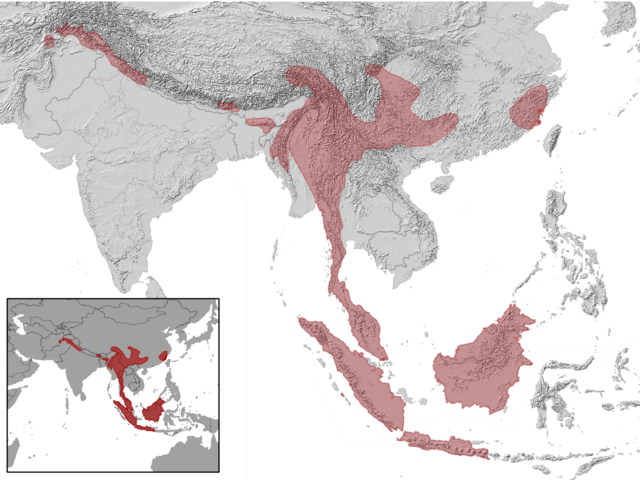 |
Size: 28–52 cm (11–20 in) long, plus 34–63 cm (13–25 in) tail[87] Habitat: Forest[132] Diet: Fruit, nuts, twigs, shoots, and leaves, as well as insects[124] |
LC
|
| Spotted giant flying squirrel | P. elegans (Müller, 1840) Seven subspecies
|
Southeastern Asia |
Size: Unknown[87] Habitat: Forest[133] Diet: Fruit, nuts, twigs, shoots, and leaves, as well as insects[124] |
LC
|
Close
More information Common name, Scientific name and subspecies ...
| Common name | Scientific name and subspecies | Range | Size and ecology | IUCN status and estimated population |
|---|---|---|---|---|
| Basilan flying squirrel
|
P. crinitus (Hollister, 1911) |
Philippines |
Size: About 31 cm (12 in) long, plus about 26 cm (10 in) tail[90] Habitat: Forest[134] Diet: Nuts, fruit, twigs, shoots, and leaves, as well as bark and insects[89] |
LC
|
| Hagen's flying squirrel
|
P. hageni (Jentink, 1888) |
Indonesia | Size: 23–28 cm (9–11 in) long, plus 23–25 cm (9–10 in) tail[90] Habitat: Forest[135] Diet: Nuts, fruit, twigs, shoots, and leaves, as well as bark and insects[89] |
DD
|
| Mindanao flying squirrel
|
P. mindanensis Rabor, 1939 |
Philippines |
Size: 32–37 cm (13–15 in) long, plus 34–46 cm (13–18 in) tail[90] Habitat: Forest[136] Diet: Nuts, fruit, twigs, shoots, and leaves, as well as bark and insects[89] |
LC
|
| Siberut flying squirrel
|
P. lugens (Thomas, 1895) |
Indonesia | Size: 23–28 cm (9–11 in) long, plus 21–23 cm (8–9 in) tail[90] Habitat: Forest[137] Diet: Nuts, fruit, twigs, shoots, and leaves, as well as bark and insects[89] |
VU
|
| Temminck's flying squirrel
|
P. setosus (Temminck, 1844) |
Southeastern Asia |
Size: 9–13 cm (4–5 in) long, plus 8–12 cm (3–5 in) tail[90] Habitat: Forest[138] Diet: Nuts, fruit, twigs, shoots, and leaves, as well as bark and insects[89] |
VU
|
| Travancore flying squirrel
|
P. fuscocapillus (Jerdon, 1847) |
Southern India | Size: 18–34 cm (7–13 in) long, plus 24–29 cm (9–11 in) tail[90] Habitat: Forest[139] Diet: Nuts, fruit, twigs, shoots, and leaves, as well as bark and insects[89] |
LC
|
| Vordermann's flying squirrel
|
P. vordermanni (Jentink, 1890) |
Southeastern Asia | Size: 9–12 cm (4–5 in) long, plus 8–12 cm (3–5 in) tail[90] Habitat: Forest[140] Diet: Nuts, fruit, twigs, shoots, and leaves, as well as bark and insects[89] |
VU
|
| Whiskered flying squirrel | P. genibarbis (Horsfield, 1822) |
Indonesia and Malaysia | Size: 14–20 cm (6–8 in) long, plus 15–20 cm (6–8 in) tail[90] Habitat: Forest[141] Diet: Nuts, fruit, twigs, shoots, and leaves, as well as bark and insects[89] |
VU
|
Close
More information Common name, Scientific name and subspecies ...
| Common name | Scientific name and subspecies | Range | Size and ecology | IUCN status and estimated population |
|---|---|---|---|---|
| Japanese dwarf flying squirrel | P. momonga Temminck, 1844 |
Japan | Size: 14–20 cm (6–8 in) long, plus 9–14 cm (4–6 in) tail[90] Habitat: Forest[142] Diet: Nuts, pine seeds, buds, bark, fruit, and insects[92] |
LC
|
| Siberian flying squirrel | P. volans (Linnaeus, 1758) Four subspecies
|
Northern Asia and northern Europe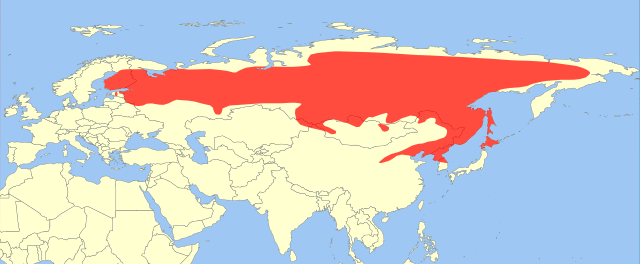 |
Size: 12–23 cm (5–9 in) long, plus 9–15 cm (4–6 in) tail[90] Habitat: Forest[143] Diet: Nuts, pine seeds, buds, bark, fruit, and insects[92] |
LC
|
Close
More information Common name, Scientific name and subspecies ...
| Common name | Scientific name and subspecies | Range | Size and ecology | IUCN status and estimated population |
|---|---|---|---|---|
| Smoky flying squirrel | P. pulverulentus (Günther, 1873) Two subspecies
|
Southeastern Asia | Size: 20–29 cm (8–11 in) long, plus 17–23 cm (7–9 in) tail[87] Habitat: Forest[144] Diet: Nuts, fruit, twigs, shoots, leaves, bark and insects[89] |
EN
|
Close
More information Common name, Scientific name and subspecies ...
| Common name | Scientific name and subspecies | Range | Size and ecology | IUCN status and estimated population |
|---|---|---|---|---|
| Tufted ground squirrel | R. macrotis (Gray, 1856) |
Borneo |
Size: 33–35 cm (13–14 in) long, plus 30–34 cm (12–13 in) tail[97] Habitat: Forest[145] Diet: Fruit and nuts[52] |
VU
|
Close
More information Common name, Scientific name and subspecies ...
| Common name | Scientific name and subspecies | Range | Size and ecology | IUCN status and estimated population |
|---|---|---|---|---|
| Abert's squirrel | S. aberti Woodhouse, 1853 Six subspecies
|
Western United States and western Mexico |
Size: 26–27 cm (10–11 in) long, plus 21–22 cm (8–9 in) tail[146] Habitat: Forest[147] Diet: Nuts, seeds, fruit, buds, and tree shoots[148] |
LC
|
| Allen's squirrel | S. alleni Nelson, 1898 |
Mexico |
Size: 22–25 cm (9–10 in) long, plus 22–25 cm (9–10 in) tail[146] Habitat: Forest[149] Diet: Nuts, seeds, fruit, buds, and tree shoots[148] |
LC
|
| Andean squirrel | S. pucheranii (Fitzinger, 1867) Three subspecies
|
Northwestern South America |
Size: 14–19 cm (6–7 in) long, plus 11–16 cm (4–6 in) tail[97] Habitat: Forest[150] Diet: Nuts, seeds, fruit, buds, and tree shoots[148] |
DD
|
| Arizona gray squirrel | S. arizonensis Coues, 1867 Three subspecies
|
Western United States and western Mexico |
Size: 25–26 cm (10 in) long, plus about 25 cm (10 in) tail[146] Habitat: Forest, shrubland, and grassland[151] Diet: Nuts, seeds, fruit, buds, and tree shoots[148] |
DD
|
| Bolivian squirrel | S. ignitus (Gray, 1867) Five subspecies
|
Western South America |
Size: 14–22 cm (6–9 in) long, plus 15–23 cm (6–9 in) tail[97] Habitat: Forest[152] Diet: Nuts, seeds, fruit, buds, and tree shoots[148] |
LC
|
| Brazilian squirrel | S. aestuans Linnaeus, 1766 Ten subspecies
|
South America |
Size: 16–19 cm (6–7 in) long, plus 16–25 cm (6–10 in) tail[97] Habitat: Forest[153] Diet: Nuts, seeds, fruit, buds, and tree shoots[148] |
LC
|
| Calabrian black squirrel | S. meridionalis Lucifero, 1907 |
Southern Italy |
Size: Unknown[146] Habitat: Forest[154] Diet: Nuts, seeds, fruit, buds, and tree shoots[148] |
NT
|
| Caucasian squirrel | S. anomalus Gmelin, 1778 Three subspecies
|
Western Asia |
Size: 19–25 cm (7–10 in) long, plus 12–17 cm (5–7 in) tail[146] Habitat: Forest[155] Diet: Nuts, seeds, fruit, buds, and tree shoots[148] |
LC
|
| Collie's squirrel | S. colliaei Richardson, 1839 Four subspecies
|
Western Mexico |
Size: 24–25 cm (9–10 in) long, plus 24–26 cm (9–10 in) tail[146] Habitat: Forest[156] Diet: Nuts, seeds, fruit, buds, and tree shoots[148] |
LC
|
| Deppe's squirrel | S. deppei Peters, 1863 Five subspecies
|
Southern Mexico and Central America |
Size: About 21 cm (8 in) long, plus 17–18 cm (7 in) tail[97] Habitat: Forest[157] Diet: Nuts, seeds, fruit, buds, and tree shoots[148] |
LC
|
| Eastern gray squirrel | S. carolinensis Gmelin, 1788 Five subspecies
|
Canada and eastern United States |
Size: 20–31 cm (8–12 in) long, plus 15–25 cm (6–10 in) tail[146] Habitat: Forest[158] Diet: Nuts, seeds, fruit, buds, and tree shoots[148] |
LC
|
| Fiery squirrel
|
S. flammifer Thomas, 1904 |
Venezuela |
Size: 27–30 cm (11–12 in) long, plus 24–31 cm (9–12 in) tail[97] Habitat: Forest[159] Diet: Nuts, seeds, fruit, buds, and tree shoots[148] |
DD
|
| Fox squirrel | S. niger Linnaeus, 1758 Ten subspecies
|
Canada and United States |
Size: 26–37 cm (10–15 in) long, plus 20–33 cm (8–13 in) tail[146] Habitat: Forest[160] Diet: Nuts, seeds, fruit, buds, and tree shoots[148] |
LC
|
| Guayaquil squirrel | S. stramineus Eydoux & Souleyet, 1841 |
Ecuador and Peru |
Size: 18–32 cm (7–13 in) long, plus 25–33 cm (10–13 in) tail[97] Habitat: Forest[161] Diet: Nuts, seeds, fruit, buds, and tree shoots[148] |
LC
|
| Japanese squirrel | S. lis Temminck, 1844 |
Japan |
Size: 16–22 cm (6–9 in) long, plus 13–17 cm (5–7 in) tail[146] Habitat: Forest[162] Diet: Nuts, seeds, fruit, buds, and tree shoots[148] |
LC
|
| Junín red squirrel | S. pyrrhinus Thomas, 1898 |
Ecuador and Peru |
Size: 24–25 cm (9–10 in) long, plus 21–25 cm (8–10 in) tail[97] Habitat: Forest[163] Diet: Nuts, seeds, fruit, buds, and tree shoots[148] |
DD
|
| Mexican fox squirrel | S. nayaritensis Allen, 1890 Three subspecies
|
Mexico and southern United States |
Size: 25–26 cm (10 in) long, plus about 25 cm (10 in) tail[146] Habitat: Forest[164] Diet: Nuts, seeds, fruit, buds, and tree shoots[148] |
LC
|
| Mexican gray squirrel | S. aureogaster F. Cuvier, 1829 Two subspecies
|
Mexico and Guatemala |
Size: 23–31 cm (9–12 in) long, plus 21–28 cm (8–11 in) tail[146] Habitat: Forest[165] Diet: Nuts, seeds, fruit, buds, and tree shoots[148] |
LC
|
| Northern Amazon red squirrel | S. igniventris Wagner, 1842 Two subspecies
|
Northwestern South America | Size: 24–29 cm (9–11 in) long, plus 24–29 cm (9–11 in) tail[97] Habitat: Forest[166] Diet: Nuts, seeds, fruit, buds, and tree shoots[148] |
LC
|
| Peters's squirrel
|
S. oculatus Peters, 1863 Three subspecies
|
Central Mexico |
Size: 51–56 cm (20–22 in) long, plus 26–27 cm (10–11 in) tail[146] Habitat: Forest[167] Diet: Nuts, seeds, fruit, buds, and tree shoots[148] |
LC
|
| Red squirrel | S. vulgaris Linnaeus, 1758 23 subspecies
|
Europe and Asia |
Size: 21–25 cm (8–10 in) long, plus 15–20 cm (6–8 in) tail[146] Habitat: Forest[168] Diet: Nuts, seeds, fruit, buds, and tree shoots[148] |
LC
|
| Red-tailed squirrel | S. granatensis (Humboldt, 1811) 32 subspecies
|
Northwestern South America and Central America |
Size: 20–28 cm (8–11 in) long, plus 14–28 cm (6–11 in) tail[97] Habitat: Forest[169] Diet: Nuts, seeds, fruit, buds, and tree shoots[148] |
LC
|
| Richmond's squirrel
|
S. richmondi Nelson, 1898 |
Nicaragua |
Size: 16–22 cm (6–9 in) long, plus 13–19 cm (5–7 in) tail[146] Habitat: Forest[170] Diet: Nuts, seeds, fruit, buds, and tree shoots[148] |
NT
|
| Sanborn's squirrel
|
S. sanborni Osgood, 1944 |
Peru and Bolivia | Size: 15–18 cm (6–7 in) long, plus 16–19 cm (6–7 in) tail[97] Habitat: Forest[171] Diet: Nuts, seeds, fruit, buds, and tree shoots[148] |
DD
|
| Southern Amazon red squirrel | S. spadiceus Olfers, 1818 Three subspecies
|
Northwestern South America | Size: 24–29 cm (9–11 in) long, plus 23–34 cm (9–13 in) tail[97] Habitat: Forest[172] Diet: Nuts, seeds, fruit, buds, and tree shoots[148] |
LC
|
| Variegated squirrel | S. variegatoides Ogilby, 1839 Fifteen subspecies
|
Southern Mexico and Central America |
Size: About 26 cm (10 in) long, plus 26–28 cm (10–11 in) tail[146] Habitat: Forest[173] Diet: Nuts, seeds, fruit, buds, and tree shoots[148] |
LC
|
| Western gray squirrel | S. griseus Ord, 1818 Three subspecies
|
Western United States and western Mexico |
Size: 26–32 cm (10–13 in) long, plus 24–31 cm (9–12 in) tail[146] Habitat: Forest[174] Diet: Nuts, seeds, fruit, buds, and tree shoots[148] |
LC
|
| Yellow-throated squirrel
|
S. gilvigularis Wagner, 1842 Two subspecies
|
Northern South America |
Size: 15–18 cm (6–7 in) long, plus 16–20 cm (6–8 in) tail[97] Habitat: Forest[175] Diet: Nuts, seeds, fruit, buds, and tree shoots[148] |
DD
|
| Yucatan squirrel | S. yucatanensis Allen, 1877 Three subspecies
|
Southern Mexico and Central America |
Size: 20–32 cm (8–13 in) long, plus 19–27 cm (7–11 in) tail[146] Habitat: Forest[176] Diet: Nuts, seeds, fruit, buds, and tree shoots[148] |
LC
|
Close
More information Common name, Scientific name and subspecies ...
| Common name | Scientific name and subspecies | Range | Size and ecology | IUCN status and estimated population |
|---|---|---|---|---|
| Bangs's mountain squirrel | S. brochus Bangs, 1902 |
Costa Rica and Panama | Size: 15–19 cm (6–7 in) long, plus 12–16 cm (5–6 in) tail[97] Habitat: Forest[177] Diet: Flowers, buds, leaves, and sap[115] |
DD
|
Close
More information Common name, Scientific name and subspecies ...
| Common name | Scientific name and subspecies | Range | Size and ecology | IUCN status and estimated population |
|---|---|---|---|---|
| American red squirrel | T. hudsonicus (Erxleben, 1777) 24 subspecies
|
Canada and United States |
Size: 18–19 cm (7 in) long, plus about 12 cm (5 in) tail[3] Habitat: Forest[178] Diet: Nuts, buds, fruit, bark, fungi, sap, eggs, and small vertebrates[179] |
LC
|
| Douglas squirrel | T. douglasii (Bachman, 1880) Two subspecies
|
Western Canada and western United States |
Size: 18–19 cm (7 in) long, plus 11–15 cm (4–6 in) tail[3] Habitat: Forest[180] Diet: Nuts, buds, fruit, bark, fungi, sap, eggs, and small vertebrates[179] |
LC
|
| Mearns's squirrel | T. mearnsi (Townsend, 1897) |
Mexico | Size: 18–19 cm (7 in) long, plus 11–15 cm (4–6 in) tail[3] Habitat: Forest[181] Diet: Nuts, buds, fruit, bark, fungi, sap, eggs, and small vertebrates[179] |
EN
|
Close
More information Common name, Scientific name and subspecies ...
| Common name | Scientific name and subspecies | Range | Size and ecology | IUCN status and estimated population |
|---|---|---|---|---|
| Complex-toothed flying squirrel | T. xanthipes (H. Milne-Edwards, 1867) |
Southern China | Size: 20–33 cm (8–13 in) long, plus 26–30 cm (10–12 in) tail[87] Habitat: Forest and caves[182] Diet: Leaves, twigs, fruit, and nuts[89] |
NT
|
Close
Subfamily Xerinae
Main article: Xerinae
More information Common name, Scientific name and subspecies ...
| Common name | Scientific name and subspecies | Range | Size and ecology | IUCN status and estimated population |
|---|---|---|---|---|
| Harris's antelope squirrel | A. harrisii (Audubon & Bachman, 1854) Two subspecies
|
Western United States and western Mexico |
Size: 27–28 cm (11 in) long, plus 6–10 cm (2–4 in) tail[183] Habitat: Desert[184] Diet: Seeds, fruit, stems, and roots, as well as insects and carrion[185] |
LC
|
| San Joaquin antelope squirrel | A. nelsoni (Merriam, 1893) |
Western United States | Size: 23–27 cm (9–11 in) long, plus 6–8 cm (2–3 in) tail[183] Habitat: Shrubland, grassland, and desert[186] Diet: Seeds, fruit, stems, and roots, as well as insects and carrion[185] |
EN
|
| Texas antelope squirrel | A. interpres (Merriam, 1890) |
Southwestern United States | Size: 22–23 cm (9 in) long, plus 6–9 cm (2–4 in) tail[183] Habitat: Shrubland, grassland, and desert[187] Diet: Seeds, fruit, stems, and roots, as well as insects and carrion[185] |
LC
|
| White-tailed antelope squirrel | A. leucurus (Merriam, 1889) Nine subspecies
|
Western United States and western Mexico |
Size: 18–22 cm (7–9 in) long, plus 4–8 cm (2–3 in) tail[183] Habitat: Desert, shrubland, and forest[188] Diet: Seeds, fruit, stems, and roots, as well as insects and carrion[185] |
LC
|
Close
More information Common name, Scientific name and subspecies ...
| Common name | Scientific name and subspecies | Range | Size and ecology | IUCN status and estimated population |
|---|---|---|---|---|
| Barbary ground squirrel | A. getulus (Linnaeus, 1758) |
Northwestern Africa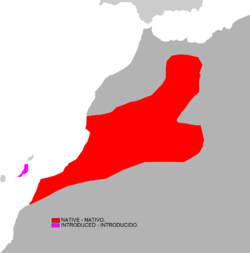 |
Size: About 17 cm (7 in) long, plus about 13 cm (5 in) tail[122] Habitat: Rocky areas, grassland, and shrubland[189] Diet: Fruit and seeds[190] |
LC
|
Close
More information Common name, Scientific name and subspecies ...
| Common name | Scientific name and subspecies | Range | Size and ecology | IUCN status and estimated population |
|---|---|---|---|---|
| Cascade golden-mantled ground squirrel | C. saturatus (Rhoads, 1895) |
Western United States and western Canada |
Size: 28–31 cm (11–12 in) long, plus 9–12 cm (4–5 in) tail[191] Habitat: Rocky areas, grassland, shrubland, and forest[192] Diet: Seeds, nuts, grains, roots, bulbs, fungi, vegetation, and insects, as well as small vertebrates and eggs[193] |
LC
|
| Golden-mantled ground squirrel | C. lateralis (Say, 1823) |
Western United States and western Canada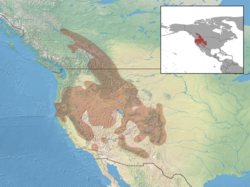 |
Size: About 18 cm (7 in) long, plus 8–9 cm (3–4 in) tail[191] Habitat: Forest, shrubland, and rocky areas[194] Diet: Seeds, nuts, grains, roots, bulbs, fungi, vegetation, and insects, as well as small vertebrates and eggs[193] |
LC
|
| Sierra Madre ground squirrel | C. madrensis Merriam, 1901 |
Western Mexico |
Size: 16–17 cm (6–7 in) long, plus 6–7 cm (2–3 in) tail[191] Habitat: Forest[195] Diet: Seeds, nuts, grains, roots, bulbs, fungi, vegetation, and insects, as well as small vertebrates and eggs[193] |
NT
|
Close
More information Common name, Scientific name and subspecies ...
| Common name | Scientific name and subspecies | Range | Size and ecology | IUCN status and estimated population |
|---|---|---|---|---|
| Black-tailed prairie dog | C. ludovicianus (Ord, 1815) Two subspecies
|
Central North America |
Size: About 37 cm (15 in) long, plus 8–9 cm (3–4 in) tail[196] Habitat: Desert, grassland, and savanna[197] Diet: Herbs and grasses[198] |
LC
|
| Gunnison's prairie dog | C. gunnisoni (Baird, 1855) Two subspecies
|
Southwestern United States |
Size: 31–39 cm (12–15 in) long, plus 4–7 cm (2–3 in) tail[196] Habitat: Shrubland, grassland, and desert[199] Diet: Herbs and grasses[198] |
LC
|
| Mexican prairie dog | C. mexicanus Merriam, 1892 |
Northern Mexico | Size: 38–44 cm (15–17 in) long, plus 10–11 cm (4 in) tail[196] Habitat: Grassland[200] Diet: Herbs and grasses[198] |
EN
|
| Utah prairie dog | C. parvidens Allen, 1905 |
Western United States |
Size: 29–37 cm (11–15 in) long, plus 4–7 cm (2–3 in) tail[196] Habitat: Grassland[201] Diet: Herbs and grasses[198] |
EN
|
| White-tailed prairie dog | C. leucurus Merriam, 1890 |
Western United States |
Size: 35–37 cm (14–15 in) long, plus 5–6 cm (2 in) tail[196] Habitat: Shrubland and grassland[202] Diet: Herbs and grasses[198] |
LC
|
Close
More information Common name, Scientific name and subspecies ...
| Common name | Scientific name and subspecies | Range | Size and ecology | IUCN status and estimated population |
|---|---|---|---|---|
| Ebian's palm squirrel | E. ebii (Temminck, 1853) Three subspecies
|
Western Africa |
Size: 28–29 cm (11 in) long, plus about 28 cm (11 in) tail[122] Habitat: Forest[203] Diet: Fruit as well as insects[204] |
LC
|
Close
More information Common name, Scientific name and subspecies ...
| Common name | Scientific name and subspecies | Range | Size and ecology | IUCN status and estimated population |
|---|---|---|---|---|
| Siberian chipmunk | E. sibiricus Laxmann, 1769 |
Northern and eastern Asia and Europe |
Size: 14–15 cm (6 in) long, plus 10–12 cm (4–5 in) tail[183] Habitat: Forest and shrubland[205] Diet: Nuts and seeds, as well as buds, berries, grains, and fungi[206] |
LC
|
Close
More information Common name, Scientific name and subspecies ...
| Common name | Scientific name and subspecies | Range | Size and ecology | IUCN status and estimated population |
|---|---|---|---|---|
| Carruther's mountain squirrel
|
F. carruthersi Thomas, 1906 Four subspecies
|
Central Africa | Size: 21–22 cm (8–9 in) long, plus 18–19 cm (7 in) tail[207] Habitat: Forest[208] Diet: Seeds, nuts, and fruit, as well as insects and eggs[209] |
LC
|
| Congo rope squirrel | F. congicus (Kuhl, 1820) |
Central Africa | Size: 16–18 cm (6–7 in) long, plus 16–17 cm (6–7 in) tail[207] Habitat: Forest, savanna, shrubland, and rocky areas[210] Diet: Seeds, nuts, and fruit, as well as insects and eggs[209] |
LC
|
| Du Chaillu's rope squirrel
|
F. duchaillui Sanborn, 1953 |
Central Africa | Size: 18–21 cm (7–8 in) long, plus 19–23 cm (7–9 in) tail[207] Habitat: Forest[211] Diet: Seeds, nuts, and fruit, as well as insects and eggs[209] |
DD
|
| Fire-footed rope squirrel | F. pyrropus (F. Cuvier, 1833) Nine subspecies
|
Central and western Africa |
Size: 19–20 cm (7–8 in) long, plus 14–16 cm (6 in) tail[207] Habitat: Forest and savanna[212] Diet: Seeds, nuts, and fruit, as well as insects and eggs[209] |
LC
|
| Kintampo rope squirrel | F. substriatus De Winton, 1899 |
Western Africa | Size: 16–17 cm (6–7 in) long, plus about 16 cm (6 in) tail[207] Habitat: Forest and savanna[213] Diet: Seeds, nuts, and fruit, as well as insects and eggs[209] |
DD
|
| Lady Burton's rope squirrel | F. isabella (Gray, 1862) Two subspecies
|
Central Africa | Size: 16–17 cm (6–7 in) long, plus 14–17 cm (6–7 in) tail[207] Habitat: Forest[214] Diet: Seeds, nuts, and fruit, as well as insects and eggs[209] |
LC
|
| Lunda rope squirrel
|
F. bayonii (Bocage, 1890) |
Central Africa | Size: 18–25 cm (7–10 in) long, plus 19–20 cm (7–8 in) tail[207] Habitat: Savanna[215] Diet: Seeds, nuts, and fruit, as well as insects and eggs[209] |
DD
|
| Red-cheeked rope squirrel | F. leucogenys (Waterhouse, 1842) Three subspecies
|
Central and western Africa | Size: 20–21 cm (8 in) long, plus 14–15 cm (6 in) tail[207] Habitat: Forest[216] Diet: Seeds, nuts, and fruit, as well as insects and eggs[209] |
LC
|
| Ribboned rope squirrel
|
F. lemniscatus (LeConte, 1857) Two subspecies
|
Central Africa | Size: 16–18 cm (6–7 in) long, plus 13–14 cm (5–6 in) tail[207] Habitat: Forest[217] Diet: Seeds, nuts, and fruit, as well as insects and eggs[209] |
LC
|
| Thomas's rope squirrel
|
F. anerythrus (Thomas, 1890) Four subspecies
|
Central and western Africa | Size: 17–18 cm (7 in) long, plus 16–17 cm (6–7 in) tail[207] Habitat: Forest and savanna[218] Diet: Seeds, nuts, and fruit, as well as insects and eggs[209] |
LC
|
Close
More information Common name, Scientific name and subspecies ...
| Common name | Scientific name and subspecies | Range | Size and ecology | IUCN status and estimated population |
|---|---|---|---|---|
| Gambian sun squirrel | H. gambianus (Ogilby, 1835) Sixteen subspecies
|
Sub-Saharan Africa | Size: 20–22 cm (8–9 in) long, plus 23–24 cm (9 in) tail[122] Habitat: Savanna and forest[219] Diet: Seeds, nuts, fruit, insects, and eggs[41] |
LC
|
| Mutable sun squirrel | H. mutabilis (Peters, 1852) Five subspecies
|
Eastern Africa | Size: 22–23 cm (9 in) long, plus 23–27 cm (9–11 in) tail[122] Habitat: Savanna and forest[220] Diet: Seeds, nuts, fruit, insects, and eggs[41] |
LC
|
| Red-legged sun squirrel | H. rufobrachium (Waterhouse, 1842) 22 subspecies
|
Central and western Africa | Size: 22–23 cm (9 in) long, plus 24–25 cm (9–10 in) tail[122] Habitat: Forest and savanna[221] Diet: Seeds, nuts, fruit, insects, and eggs[41] |
LC
|
| Ruwenzori sun squirrel | H. ruwenzorii (Schwann, 1904) Four subspecies
|
Central Africa | Size: 21–22 cm (8–9 in) long, plus about 25 cm (10 in) tail[122] Habitat: Forest[222] Diet: Seeds, nuts, fruit, insects, and eggs[41] |
LC
|
| Small sun squirrel | H. punctatus (Temminck, 1853) Two subspecies
|
Western Africa | Size: 18–19 cm (7 in) long, plus 20–21 cm (8 in) tail[122] Habitat: Forest[223] Diet: Seeds, nuts, fruit, insects, and eggs[41] |
DD
|
| Zanj sun squirrel | H. undulatus (True, 1892) |
Eastern Africa | Size: 23–24 cm (9 in) long, plus 26–27 cm (10–11 in) tail[122] Habitat: Forest[224] Diet: Seeds, nuts, fruit, insects, and eggs[41] |
DD
|
Close
More information Common name, Scientific name and subspecies ...
| Common name | Scientific name and subspecies | Range | Size and ecology | IUCN status and estimated population |
|---|---|---|---|---|
| Mexican ground squirrel | I. mexicanus (Erxleben, 1777) |
Mexico and southern United States | Size: 32–38 cm (13–15 in) long, plus 12–17 cm (5–7 in) tail[191] Habitat: Grassland and shrubland[225] Diet: Seeds, nuts, grains, roots, bulbs, fungi, vegetation, and insects, as well as small vertebrates and eggs[193] |
LC
|
| Thirteen-lined ground squirrel | I. tridecemlineatus (Mitchill, 1821) |
United States and Canada |
Size: 17–31 cm (7–12 in) long, plus 6–14 cm (2–6 in) tail[191] Habitat: Shrubland, grassland, and coastal marine[226] Diet: Seeds, nuts, grains, roots, bulbs, fungi, vegetation, and insects, as well as small vertebrates and eggs[193] |
LC
|
Close
More information Common name, Scientific name and subspecies ...
| Common name | Scientific name and subspecies | Range | Size and ecology | IUCN status and estimated population |
|---|---|---|---|---|
| Alaska marmot | M. broweri Hall & Gilmore, 1934 |
Northern Alaska |
Size: 54–65 cm (21–26 in) long, plus 13–18 cm (5–7 in) tail[191] Habitat: Grassland and rocky areas[227] Diet: Grass and forbs, as well as fruit, grains, legumes, and insects[228] |
LC
|
| Alpine marmot | M. marmota (Linnaeus, 1758) Two subspecies
|
Europe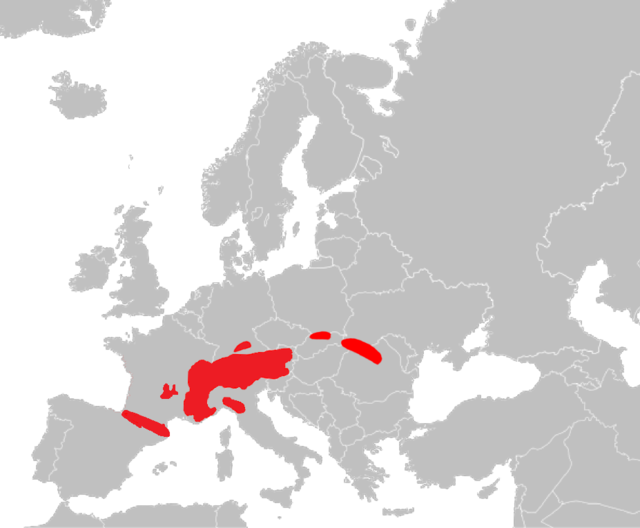 |
Size: 50–60 cm (20–24 in) long, plus 14–17 cm (6–7 in) tail[191] Habitat: Grassland and rocky areas[229] Diet: Grass and forbs, as well as fruit, grains, legumes, and insects[228] |
LC
|
| Black-capped marmot | M. camtschatica (Pallas, 1811) Three subspecies
|
Eastern Russia | Size: 46–53 cm (18–21 in) long, plus about 17 cm (7 in) tail[191] Habitat: Grassland[230] Diet: Grass and forbs, as well as fruit, grains, legumes, and insects[228] |
LC
|
| Bobak marmot | M. bobak (P. L. S. Müller, 1776) Two subspecies
|
Western Asia and eastern Europe |
Size: 49–57 cm (19–22 in) long, plus 10–13 cm (4–5 in) tail[191] Habitat: Grassland[231] Diet: Grass and forbs, as well as fruit, grains, legumes, and insects[228] |
LC
|
| Gray marmot | M. baibacina Kaschtschenko, 1899 Three subspecies
|
Central Asia | Size: 46–65 cm (18–26 in) long, plus 13–16 cm (5–6 in) tail[191] Habitat: Other and grassland[232] Diet: Grass and forbs, as well as fruit, grains, legumes, and insects[228] |
LC
|
| Groundhog | M. monax (Linnaeus, 1758) Four subspecies
|
United States and Canada |
Size: 42–66 cm (17–26 in) long, plus 10–16 cm (4–6 in) tail[191] Habitat: Forest and grassland[233] Diet: Grass and forbs, as well as fruit, grains, legumes, and insects[228] |
LC
|
| Himalayan marmot | M. himalayana (Hodgson, 1841) Two subspecies
|
Nepal and western China | Size: 46–65 cm (18–26 in) long, plus 12–15 cm (5–6 in) tail[191] Habitat: Shrubland, grassland, rocky areas, and desert[234] Diet: Grass and forbs, as well as fruit, grains, legumes, and insects[228] |
LC
|
| Hoary marmot | M. caligata (Eschscholtz, 1829) Three subspecies
|
Western United States and western Canada | Size: 45–60 cm (18–24 in) long, plus 17–25 cm (7–10 in) tail[207] Habitat: Rocky areas and grassland[235] Diet: Grass and forbs, as well as fruit, grains, legumes, and insects[228] |
LC
|
| Long-tailed marmot | M. caudata (Geoffroy, 1844) Three subspecies
|
Central Asia | Size: About 50 cm (20 in) long, plus about 18 cm (7 in) tail[191] Habitat: Shrubland, grassland, and rocky areas[236] Diet: Grass and forbs, as well as fruit, grains, legumes, and insects[228] |
LC
|
| Menzbier's marmot | M. menzbieri (Kashkarov, 1925) Two subspecies
|
Central Asia | Size: About 49 cm (19 in) long, plus about 12 cm (5 in) tail[191] Habitat: Forest[237] Diet: Grass and forbs, as well as fruit, grains, legumes, and insects[228] |
VU
|
| Olympic marmot | M. olympus (Merriam, 1898) |
Northwestern United States |
Size: 67–75 cm (26–30 in) long, plus 18–24 cm (7–9 in) tail[207] Habitat: Forest and grassland[238] Diet: Grass and forbs, as well as fruit, grains, legumes, and insects[228] |
LC
|
| Tarbagan marmot | M. sibirica (Radde, 1862) Two subspecies
|
Central Asia | Size: 36–49 cm (14–19 in) long, plus 11–12 cm (4–5 in) tail[191] Habitat: Shrubland, grassland, and other[239] Diet: Grass and forbs, as well as fruit, grains, legumes, and insects[228] |
EN
|
| Vancouver Island marmot | M. vancouverensis (Swarth, 1911) |
Vancouver Island in western Canada |
Size: 66–69 cm (26–27 in) long, plus 19–22 cm (7–9 in) tail[207] Habitat: Forest, grassland, and rocky areas[240] Diet: Grass and forbs, as well as fruit, grains, legumes, and insects[228] |
CR
|
| Yellow-bellied marmot | M. flaviventris (Audubon & Bachman, 1841) Seven subspecies
|
Western United States and western Canada |
Size: 47–70 cm (19–28 in) long, plus 13–22 cm (5–9 in) tail[191] Habitat: Forest, grassland, and rocky areas[241] Diet: Grass and forbs, as well as fruit, grains, legumes, and insects[228] |
LC
|
Close
More information Common name, Scientific name and subspecies ...
| Common name | Scientific name and subspecies | Range | Size and ecology | IUCN status and estimated population |
|---|---|---|---|---|
| African pygmy squirrel
|
M. pumilio (LeConte, 1857) |
Western Africa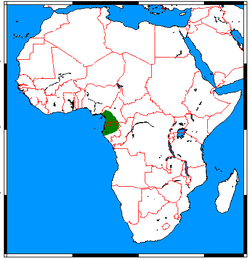 |
Size: 7–8 cm (3 in) long, plus 5–6 cm (2 in) tail[122] Habitat: Forest[242] Diet: Fruit, bark, and insects[41] |
LC
|
Close
More information Common name, Scientific name and subspecies ...
| Common name | Scientific name and subspecies | Range | Size and ecology | IUCN status and estimated population |
|---|---|---|---|---|
| Allen's chipmunk | N. senex (Allen, 1890) |
Western United States | Size: 14–15 cm (6 in) long, plus 10–11 cm (4 in) tail[243] Habitat: Shrubland and forest[244] Diet: Fruit and seeds, as well as flowers, fungi, insects, and eggs[206] |
LC
|
| Alpine chipmunk | N. alpinus (Merriam, 1893) |
Western United States | Size: 10–11 cm (4 in) long, plus 6–8 cm (2–3 in) tail[183] Habitat: Rocky areas and forest[245] Diet: Fruit and seeds, as well as flowers, fungi, insects, and eggs[206] |
LC
|
| Buller's chipmunk
|
N. bulleri (Allen, 1889) |
Mexico | Size: 13–14 cm (5–6 in) long, plus 8–11 cm (3–4 in) tail[243] Habitat: Shrubland and forest[246] Diet: Fruit and seeds, as well as flowers, fungi, insects, and eggs[206] |
VU
|
| California chipmunk | N. obscurus (Allen, 1890) |
Western United States and western Mexico | Size: 12–13 cm (5 in) long, plus 10–12 cm (4–5 in) tail[243] Habitat: Desert and shrubland[247] Diet: Fruit and seeds, as well as flowers, fungi, insects, and eggs[206] |
LC
|
| Cliff chipmunk | N. dorsalis (Baird, 1855) |
Western United States and western Mexico |
Size: 12–13 cm (5 in) long, plus 8–11 cm (3–4 in) tail[243] Habitat: Forest and shrubland[248] Diet: Fruit and seeds, as well as flowers, fungi, insects, and eggs[206] |
LC
|
| Colorado chipmunk | N. quadrivittatus (Say, 1823) |
Western United States |
Size: 12–14 cm (5–6 in) long, plus about 10 cm (4 in) tail[243] Habitat: Rocky areas, shrubland, and forest[249] Diet: Fruit and seeds, as well as flowers, fungi, insects, and eggs[206] |
LC
|
| Durango chipmunk
|
N. durangae (Allen, 1903) |
Mexico | Size: 12–16 cm (5–6 in) long, plus 8–11 cm (3–4 in) tail[243] Habitat: Forest[250] Diet: Fruit and seeds, as well as flowers, fungi, insects, and eggs[206] |
LC
|
| Gray-collared chipmunk | N. cinereicollis (Allen, 1890) |
Southwestern United States | Size: 12–14 cm (5–6 in) long, plus 9–11 cm (4 in) tail[243] Habitat: Forest[251] Diet: Fruit and seeds, as well as flowers, fungi, insects, and eggs[206] |
LC
|
| Gray-footed chipmunk | N. canipes (Bailey, 1902) |
Southwestern United States |
Size: 12–14 cm (5–6 in) long, plus 9–11 cm (4 in) tail[243] Habitat: Forest, shrubland, and rocky areas[252] Diet: Fruit and seeds, as well as flowers, fungi, insects, and eggs[206] |
LC
|
| Hopi chipmunk | N. rufus (Hoffmeister & Ellis, 1979) |
Southwestern United States | Size: 12–13 cm (5 in) long, plus 9–10 cm (4 in) tail[243] Habitat: Forest, shrubland, rocky areas, and desert[253] Diet: Fruit and seeds, as well as flowers, fungi, insects, and eggs[206] |
LC
|
| Least chipmunk | N. minimus (Bachman, 1839) |
Canada and United States |
Size: 10–12 cm (4–5 in) long, plus 8–9 cm (3–4 in) tail[183] Habitat: Forest, shrubland, grassland, and desert[254] Diet: Fruit and seeds, as well as flowers, fungi, insects, and eggs[206] |
LC
|
| Lodgepole chipmunk | N. speciosus (Merriam, 1890) |
Western United States |
Size: 12–13 cm (5 in) long, plus 8–10 cm (3–4 in) tail[243] Habitat: Forest and grassland[255] Diet: Fruit and seeds, as well as flowers, fungi, insects, and eggs[206] |
LC
|
| Long-eared chipmunk | N. quadrimaculatus (J. E. Gray, 1867) |
Western United States |
Size: 13–14 cm (5–6 in) long, plus 9–11 cm (4 in) tail[243] Habitat: Forest and shrubland[256] Diet: Fruit and seeds, as well as flowers, fungi, insects, and eggs[206] |
LC
|
| Merriam's chipmunk | N. merriami (Allen, 1889) |
Western United States and western Mexico | Size: 13–14 cm (5–6 in) long, plus 10–12 cm (4–5 in) tail[243] Habitat: Forest and shrubland[257] Diet: Fruit and seeds, as well as flowers, fungi, insects, and eggs[206] |
LC
|
| Palmer's chipmunk | N. palmeri (Merriam, 1897) |
Western United States | Size: 12–13 cm (5 in) long, plus 8–10 cm (3–4 in) tail[243] Habitat: Forest and rocky areas[258] Diet: Fruit and seeds, as well as flowers, fungi, insects, and eggs[206] |
EN
|
| Panamint chipmunk | N. panamintinus (Merriam, 1893) |
Western United States | Size: 10–11 cm (4–4 in) long, plus 8–10 cm (3–4 in) tail[183] Habitat: Forest and rocky areas[259] Diet: Fruit and seeds, as well as flowers, fungi, insects, and eggs[206] |
LC
|
| Red-tailed chipmunk | N. ruficaudus (Howell, 1920) |
Western United States and western Canada |
Size: 12–13 cm (5 in) long, plus 9–11 cm (4 in) tail[243] Habitat: Forest[260] Diet: Fruit and seeds, as well as flowers, fungi, insects, and eggs[206] |
LC
|
| Siskiyou chipmunk | N. siskiyou (Howell, 1922) |
Western United States | Size: 14–15 cm (6 in) long, plus 10–11 cm (4 in) tail[243] Habitat: Forest[261] Diet: Fruit and seeds, as well as flowers, fungi, insects, and eggs[206] |
LC
|
| Sonoma chipmunk | N. sonomae (Grinnell, 1915) |
Western United States |
Size: 13–14 cm (5–6 in) long, plus 10–12 cm (4–5 in) tail[243] Habitat: Forest and shrubland[262] Diet: Fruit and seeds, as well as flowers, fungi, insects, and eggs[206] |
LC
|
| Townsend's chipmunk | N. townsendii (Bachman, 1839) |
Western United States and western Canada |
Size: 13–15 cm (5–6 in) long, plus 11–12 cm (4–5 in) tail[243] Habitat: Forest[263] Diet: Fruit and seeds, as well as flowers, fungi, insects, and eggs[206] |
LC
|
| Uinta chipmunk | N. umbrinus (Allen, 1890) |
Western United States | Size: 12–13 cm (5 in) long, plus 8–12 cm (3–5 in) tail[243] Habitat: Shrubland and forest[264] Diet: Fruit and seeds, as well as flowers, fungi, insects, and eggs[206] |
LC
|
| Yellow-cheeked chipmunk | N. ochrogenys (Merriam, 1897) |
Western United States | Size: 14–16 cm (6 in) long, plus 10–12 cm (4–5 in) tail[243] Habitat: Forest[265] Diet: Fruit and seeds, as well as flowers, fungi, insects, and eggs[206] |
LC
|
| Yellow-pine chipmunk | N. amoenus (Allen, 1890) |
Western United States and western Canda |
Size: 11–13 cm (4–5 in) long, plus 8–10 cm (3–4 in) tail[243] Habitat: Shrubland, grassland, and rocky areas[266] Diet: Fruit and seeds, as well as flowers, fungi, insects, and eggs[206] |
LC
|
Close
More information Common name, Scientific name and subspecies ...
| Common name | Scientific name and subspecies | Range | Size and ecology | IUCN status and estimated population |
|---|---|---|---|---|
| Ring-tailed ground squirrel
|
N. annulatus (Audubon & Bachman, 1842) |
Central Mexico | Size: About 22 cm (9 in) long, plus about 21 cm (8 in) tail[183] Habitat: Forest[267] Diet: Seeds, nuts, grains, roots, bulbs, fungi, vegetation, and insects, as well as small vertebrates and eggs[193] |
LC
|
| Tropical ground squirrel | N. adocetus (Merriam, 1903) |
Mexico | Size: 16–18 cm (6–7 in) long, plus 13–15 cm (5–6 in) tail[183] Habitat: Rocky areas, shrubland, and forest[268] Diet: Seeds, nuts, grains, roots, bulbs, fungi, vegetation, and insects, as well as small vertebrates and eggs[193] |
LC
|
Close
More information Common name, Scientific name and subspecies ...
| Common name | Scientific name and subspecies | Range | Size and ecology | IUCN status and estimated population |
|---|---|---|---|---|
| California ground squirrel | O. beecheyi (Richardson, 1829) |
Western United States and western Mexico | Size: About 28 cm (11 in) long, plus about 13 cm (5 in) tail[191] Habitat: Shrubland and grassland[269] Diet: Seeds, nuts, grains, roots, bulbs, fungi, vegetation, and insects, as well as small vertebrates and eggs[193] |
LC
|
| Rock squirrel | O. variegatus (Erxleben, 1777) |
Mexico and southwestern United States | Size: 43–54 cm (17–21 in) long, plus 17–26 cm (7–10 in) tail[191] Habitat: Shrubland and rocky areas[270] Diet: Seeds, nuts, grains, roots, bulbs, fungi, vegetation, and insects, as well as small vertebrates and eggs[193] |
LC
|
Close
More information Common name, Scientific name and subspecies ...
| Common name | Scientific name and subspecies | Range | Size and ecology | IUCN status and estimated population |
|---|---|---|---|---|
| Alexander's bush squirrel | P. alexandri (Thomas & Wroughton, 1907) |
Central Africa | Size: 13–15 cm (5–6 in) long, plus 10–12 cm (4–5 in) tail[207] Habitat: Forest[271] Diet: Seeds and fruit, as well as roots and eggs[209] |
LC
|
| Black and red bush squirrel | P. lucifer (Thomas, 1897) |
Southeastern Africa | Size: About 23 cm (9 in) long, plus 19–20 cm (7–8 in) tail[207] Habitat: Forest[272] Diet: Seeds and fruit, as well as roots and eggs[209] |
DD
|
| Boehm's bush squirrel
|
P. boehmi (Reichenow, 1886) Four subspecies
|
Central Africa | Size: About 13 cm (5 in) long, plus 13–15 cm (5–6 in) tail[207] Habitat: Savanna and forest[273] Diet: Seeds and fruit, as well as roots and eggs[209] |
LC
|
| Cooper's mountain squirrel | P. cooperi (Hayman, 1950) |
Western Africa | Size: 19–20 cm (7–8 in) long, plus about 19 cm (7 in) tail[207] Habitat: Forest[274] Diet: Seeds and fruit, as well as roots and eggs[209] |
DD
|
| Green bush squirrel | P. poensis (Smith, 1830) |
Central and western Africa | Size: 15–16 cm (6 in) long, plus 15–17 cm (6–7 in) tail[207] Habitat: Forest and shrubland[275] Diet: Seeds and fruit, as well as roots and eggs[209] |
LC
|
| Ochre bush squirrel | P. ochraceus (Huet, 1880) Eight subspecies
|
Eastern Africa | Size: 16–17 cm (6–7 in) long, plus 16–17 cm (6–7 in) tail[207] Habitat: Forest, savanna, and shrubland[276] Diet: Seeds and fruit, as well as roots and eggs[209] |
LC
|
| Red bush squirrel | P. palliatus (Peters, 1852) Seven subspecies
|
Eastern Africa | Size: About 21 cm (8 in) long, plus 20–21 cm (8 in) tail[207] Habitat: Forest and shrubland[277] Diet: Seeds and fruit, as well as roots and eggs[209] |
LC
|
| Smith's bush squirrel | P. cepapi (Smith, 1836) Ten subspecies
|
Southern Africa |
Size: About 23 cm (9 in) long, plus about 18 cm (7 in) tail[207] Habitat: Shrubland and savanna[278] Diet: Seeds and fruit, as well as roots and eggs[209] |
LC
|
| Striped bush squirrel | P. flavovittis (Peters, 1852) Four subspecies
|
Eastern Africa | Size: 16–18 cm (6–7 in) long, plus 15–17 cm (6–7 in) tail[207] Habitat: Savanna[279] Diet: Seeds and fruit, as well as roots and eggs[209] |
LC
|
| Swynnerton's bush squirrel | P. vexillarius (Kershaw, 1923) Two subspecies
|
Tanzania | Size: 21–23 cm (8–9 in) long, plus 18–19 cm (7 in) tail[207] Habitat: Forest[280] Diet: Seeds and fruit, as well as roots and eggs[209] |
LC
|
| Vincent's bush squirrel
|
P. vincenti Hayman, 1950 |
Mozambique | Size: 21–22 cm (8–9 in) long, plus about 21 cm (8 in) tail[207] Habitat: Forest[281] Diet: Seeds and fruit, as well as roots and eggs[209] |
EN
|
Close
More information Common name, Scientific name and subspecies ...
| Common name | Scientific name and subspecies | Range | Size and ecology | IUCN status and estimated population |
|---|---|---|---|---|
| Franklin's ground squirrel | P. franklinii (Sabine, 1822) |
Central United States and southern Canada | Size: 23–24 cm (9 in) long, plus about 13 cm (5 in) tail[191] Habitat: Savanna, grassland, and inland wetlands[282] Diet: Seeds, nuts, grains, roots, bulbs, fungi, vegetation, and insects, as well as small vertebrates and eggs[193] |
LC
|
Close
More information Common name, Scientific name and subspecies ...
| Common name | Scientific name and subspecies | Range | Size and ecology | IUCN status and estimated population |
|---|---|---|---|---|
| Forest giant squirrel | P. stangeri (Waterhouse, 1842) Twelve subspecies
|
Western and central Africa | Size: 28–30 cm (11–12 in) long, plus 30–31 cm (12 in) tail[122] Habitat: Forest[283] Diet: Seeds, nuts, and fruit[204] |
LC
|
| Slender-tailed squirrel
|
P. aubinnii (Gray, 1873) Two subspecies
|
Western Africa | Size: 24–25 cm (9–10 in) long, plus about 30 cm (12 in) tail[122] Habitat: Forest[284] Diet: Seeds, nuts, and fruit[204] |
NT
|
Close
More information Common name, Scientific name and subspecies ...
| Common name | Scientific name and subspecies | Range | Size and ecology | IUCN status and estimated population |
|---|---|---|---|---|
| Forrest's rock squirrel
|
S. forresti (Thomas, 1922) |
Southern China | Size: About 22 cm (9 in) long, plus about 16 cm (6 in) tail[243] Habitat: Rocky areas and shrubland[285] Diet: Fruit and seeds[190] |
LC
|
| Père David's rock squirrel | S. davidianus (H. Milne-Edwards, 1867) Two subspecies
|
China |
Size: 20–21 cm (8 in) long, plus 14–15 cm (6 in) tail[243] Habitat: Rocky areas[286] Diet: Fruit and seeds[190] |
LC
|
Close
More information Common name, Scientific name and subspecies ...
| Common name | Scientific name and subspecies | Range | Size and ecology | IUCN status and estimated population |
|---|---|---|---|---|
| Long-clawed ground squirrel | S. leptodactylus (Lichtenstein, 1823) Three subspecies
|
Central Asia | Size: 23–27 cm (9–11 in) long, plus 2–9 cm (1–4 in) tail[122] Habitat: Desert, grassland, and shrubland[287] Diet: Fruit, seeds, vegetation, and insects[288] |
LC
|
Close
More information Common name, Scientific name and subspecies ...
| Common name | Scientific name and subspecies | Range | Size and ecology | IUCN status and estimated population |
|---|---|---|---|---|
| Alashan ground squirrel | S. alaschanicus (Büchner, 1888) |
China and Mongolia | Size: About 22 cm (9 in) long, plus about 8 cm (3 in) tail[183] Habitat: Grassland, rocky areas, and desert[289] Diet: Seeds, nuts, grains, roots, bulbs, fungi, vegetation, and insects, as well as small vertebrates and eggs[193] |
LC
|
| Asia Minor ground squirrel | S. xanthoprymnus (Bennett, 1835) |
Western Asia | Size: 14–23 cm (6–9 in) long, plus 3–4 cm (1–2 in) tail[196] Habitat: Grassland[290] Diet: Seeds, nuts, grains, roots, bulbs, fungi, vegetation, and insects, as well as small vertebrates and eggs[193] |
NT
|
| Brandt's ground squirrel
|
S. brevicauda (Brandt, 1843) |
Central Asia | Size: About 28 cm (11 in) long, plus about 5 cm (2 in) tail[183] Habitat: Shrubland and grassland[291] Diet: Seeds, nuts, grains, roots, bulbs, fungi, vegetation, and insects, as well as small vertebrates and eggs[193] |
LC
|
| Caucasian Mountain ground squirrel | S. musicus Ménétries, 1823 |
Southwestern Russia | Size: 20–24 cm (8–9 in) long, plus 3–5 cm (1–2 in) tail[183] Habitat: Shrubland and grassland[292] Diet: Seeds, nuts, grains, roots, bulbs, fungi, vegetation, and insects, as well as small vertebrates and eggs[193] |
LC
|
| Daurian ground squirrel
|
S. dauricus Brandt, 1843 |
Eastern Asia | Size: About 19 cm (7 in) long, plus 5–7 cm (2–3 in) tail[183] Habitat: Grassland[293] Diet: Seeds, nuts, grains, roots, bulbs, fungi, vegetation, and insects, as well as small vertebrates and eggs[193] |
LC
|
| European ground squirrel | S. citellus (Linnaeus, 1766) |
Eastern Europe |
Size: 17–23 cm (7–9 in) long, plus 3–9 cm (1–4 in) tail[196] Habitat: Grassland[294] Diet: Seeds, nuts, grains, roots, bulbs, fungi, vegetation, and insects, as well as small vertebrates and eggs[193] |
EN
|
| Little ground squirrel | S. pygmaeus (Pallas, 1778) |
Eastern Europe and western Asia | Size: 17–26 cm (7–10 in) long, plus 2–5 cm (1–2 in) tail[183] Habitat: Grassland[295] Diet: Seeds, nuts, grains, roots, bulbs, fungi, vegetation, and insects, as well as small vertebrates and eggs[193] |
LC
|
| Pallid ground squirrel
|
S. pallidicauda (Satunin, 1903) |
Mongolia | Size: 19–23 cm (7–9 in) long, plus 3–6 cm (1–2 in) tail[183] Habitat: Grassland[296] Diet: Seeds, nuts, grains, roots, bulbs, fungi, vegetation, and insects, as well as small vertebrates and eggs[193] |
LC
|
| Red-cheeked ground squirrel | S. erythrogenys Brandt, 1841 |
Central Asia | Size: 18–20 cm (7–8 in) long, plus 4–5 cm (2 in) tail[183] Habitat: Shrubland[297] Diet: Seeds, nuts, grains, roots, bulbs, fungi, vegetation, and insects, as well as small vertebrates and eggs[193] |
LC
|
| Relict ground squirrel | S. relictus (Kashkarov, 1923) |
Central Asia | Size: 23–27 cm (9–11 in) long, plus 5–8 cm (2–3 in) tail[183] Habitat: Grassland[298] Diet: Seeds, nuts, grains, roots, bulbs, fungi, vegetation, and insects, as well as small vertebrates and eggs[193] |
LC
|
| Russet ground squirrel | S. major (Pallas, 1779) |
Central Asia | Size: 25–32 cm (10–13 in) long, plus 7–11 cm (3–4 in) tail[183] Habitat: Grassland[299] Diet: Seeds, nuts, grains, roots, bulbs, fungi, vegetation, and insects, as well as small vertebrates and eggs[193] |
NT
|
| Speckled ground squirrel | S. suslicus (Güldenstädt, 1770) |
Eastern Europe and western Asia |
Size: 18–26 cm (7–10 in) long, plus 3–6 cm (1–2 in) tail[196] Habitat: Grassland[300] Diet: Seeds, nuts, grains, roots, bulbs, fungi, vegetation, and insects, as well as small vertebrates and eggs[193] |
CR
|
| Taurus ground squirrel
|
S. taurensis Gündüz, Jaarola, Tez, Yeniyurt, Polly, & Searle, 2007 |
Turkey | Size: About 20 cm (8 in) long, plus about 6 cm (2 in) tail[196] Habitat: Unknown[301] Diet: Seeds, nuts, grains, roots, bulbs, fungi, vegetation, and insects, as well as small vertebrates and eggs[193] |
LC
|
| Tian Shan ground squirrel
|
S. nilkaensis Kuznetsov, 1948 |
Western China | Size: 20–24 cm (8–9 in) long, plus 6–8 cm (2–3 in) tail[183] Habitat: Grassland[302] Diet: Seeds, nuts, grains, roots, bulbs, fungi, vegetation, and insects, as well as small vertebrates and eggs[193] |
LC
|
| Yellow ground squirrel | S. fulvus (Lichtenstein, 1823) Three subspecies
|
Central Asia | Size: 22–28 cm (9–11 in) long, plus 7–9 cm (3–4 in) tail[183] Habitat: Grassland and desert[303] Diet: Seeds, nuts, grains, roots, bulbs, fungi, vegetation, and insects, as well as small vertebrates and eggs[193] |
LC
|
Close
More information Common name, Scientific name and subspecies ...
| Common name | Scientific name and subspecies | Range | Size and ecology | IUCN status and estimated population |
|---|---|---|---|---|
| Eastern chipmunk | T. striatus (Linnaeus, 1758) |
Eastern United States and eastern Canada |
Size: 14–15 cm (6 in) long, plus 8–10 cm (3–4 in) tail[183] Habitat: Shrubland and forest[304] Diet: Nuts, seeds, fruit, and fungi[206] |
LC
|
Close
More information Common name, Scientific name and subspecies ...
| Common name | Scientific name and subspecies | Range | Size and ecology | IUCN status and estimated population |
|---|---|---|---|---|
| Arctic ground squirrel | U. parryii Richardson, 1825 |
Northern Canada, Alaska, and eastern Russia |
Size: 26–27 cm (10–11 in) long, plus 8–11 cm (3–4 in) tail[196] Habitat: Forest and grassland[305] Diet: Seeds, nuts, grains, roots, bulbs, fungi, vegetation, and insects, as well as small vertebrates and eggs[193] |
LC
|
| Belding's ground squirrel | U. beldingi (Merriam, 1888) |
Western United States |
Size: 20–21 cm (8 in) long, plus 6–7 cm (2–3 in) tail[196] Habitat: Grassland and shrubland[306] Diet: Seeds, nuts, grains, roots, bulbs, fungi, vegetation, and insects, as well as small vertebrates and eggs[193] |
LC
|
| Columbian ground squirrel | U. columbianus (Ord, 1815) |
Western United States and western Canada |
Size: 25–26 cm (10 in) long, plus 8–11 cm (3–4 in) tail[196] Habitat: Forest, shrubland, and grassland[307] Diet: Seeds, nuts, grains, roots, bulbs, fungi, vegetation, and insects, as well as small vertebrates and eggs[193] |
LC
|
| Long-tailed ground squirrel | U. undulatus Pallas, 1778 |
Central and eastern Asia | Size: 21–31 cm (8–12 in) long, plus 10–14 cm (4–6 in) tail[196] Habitat: Grassland and desert[308] Diet: Seeds, nuts, grains, roots, bulbs, fungi, vegetation, and insects, as well as small vertebrates and eggs[193] |
LC
|
| Merriam's ground squirrel | U. canus (Merriam, 1898) |
Western United States | Size: 15–16 cm (6 in) long, plus 3–5 cm (1–2 in) tail[196] Habitat: Shrubland, grassland, and desert[309] Diet: Seeds, nuts, grains, roots, bulbs, fungi, vegetation, and insects, as well as small vertebrates and eggs[193] |
LC
|
| Northern Idaho ground squirrel | U. brunneus (Howell, 1928) |
Western United States |
Size: 17–18 cm (7 in) long, plus about 6 cm (2 in) tail[196] Habitat: Shrubland and grassland[310] Diet: Seeds, nuts, grains, roots, bulbs, fungi, vegetation, and insects, as well as small vertebrates and eggs[193] |
EN
|
| Piute ground squirrel | U. mollis (Kennicott, 1863) |
Western United States | Size: 20–23 cm (8–9 in) long, plus 4–7 cm (2–3 in) tail[196] Habitat: Shrubland, grassland, and desert[311] Diet: Seeds, nuts, grains, roots, bulbs, fungi, vegetation, and insects, as well as small vertebrates and eggs[193] |
LC
|
| Richardson's ground squirrel | U. richardsonii (Sabine, 1822) |
Northern United States and southern Canada |
Size: 26–34 cm (10–13 in) long, plus 5–9 cm (2–4 in) tail[196] Habitat: Grassland[312] Diet: Seeds, nuts, grains, roots, bulbs, fungi, vegetation, and insects, as well as small vertebrates and eggs[193] |
LC
|
| Townsend's ground squirrel | U. townsendii (Bachman, 1839) |
Northwestern United States | Size: 20–23 cm (8–9 in) long, plus 3–6 cm (1–2 in) tail[196] Habitat: Shrubland and desert[313] Diet: Seeds, nuts, grains, roots, bulbs, fungi, vegetation, and insects, as well as small vertebrates and eggs[193] |
VU
|
| Uinta ground squirrel | U. armatus (Kennicott, 1863) |
Western United States | Size: About 22 cm (9 in) long, plus 6–8 cm (2–3 in) tail[196] Habitat: Shrubland and grassland[314] Diet: Seeds, nuts, grains, roots, bulbs, fungi, vegetation, and insects, as well as small vertebrates and eggs[193] |
LC
|
| Washington ground squirrel | U. washingtoni (Howell, 1938) |
Northwestern United States | Size: 18–24 cm (7–9 in) long, plus 3–7 cm (1–3 in) tail[196] Habitat: Shrubland and grassland[315] Diet: Seeds, nuts, grains, roots, bulbs, fungi, vegetation, and insects, as well as small vertebrates and eggs[193] |
NT
|
| Wyoming ground squirrel | U. elegans (Kennicott, 1863) |
Northwestern United States | Size: About 20 cm (8 in) long, plus about 7 cm (3 in) tail[196] Habitat: Grassland and shrubland[316] Diet: Seeds, nuts, grains, roots, bulbs, fungi, vegetation, and insects, as well as small vertebrates and eggs[193] |
LC
|
Close
More information Common name, Scientific name and subspecies ...
| Common name | Scientific name and subspecies | Range | Size and ecology | IUCN status and estimated population |
|---|---|---|---|---|
| Mohave ground squirrel | X. mohavensis (Merriam, 1889) |
Western United States | Size: 21–23 cm (8–9 in) long, plus 5–8 cm (2–3 in) tail[196] Habitat: Desert[317] Diet: Seeds, nuts, grains, roots, bulbs, fungi, vegetation, and insects, as well as small vertebrates and eggs[193] |
NT
|
| Perote ground squirrel | X. perotensis (Merriam, 1893) |
Central Mexico | Size: 24–26 cm (9–10 in) long, plus 5–8 cm (2–3 in) tail[196] Habitat: Forest, grassland, and desert[318] Diet: Seeds, nuts, grains, roots, bulbs, fungi, vegetation, and insects, as well as small vertebrates and eggs[193] |
EN
|
| Round-tailed ground squirrel | X. tereticaudus (Baird, 1858) |
Southwestern United States and Northwestern Mexico | Size: 20–28 cm (8–11 in) long, plus 6–12 cm (2–5 in) tail[196] Habitat: Desert[319] Diet: Seeds, nuts, grains, roots, bulbs, fungi, vegetation, and insects, as well as small vertebrates and eggs[193] |
LC
|
| Spotted ground squirrel | X. spilosoma (Bennett, 1833) |
Mexico and central and western United States | Size: 18–25 cm (7–10 in) long, plus 5–10 cm (2–4 in) tail[196] Habitat: Grassland and desert[320] Diet: Seeds, nuts, grains, roots, bulbs, fungi, vegetation, and insects, as well as small vertebrates and eggs[193] |
LC
|
Close
More information Common name, Scientific name and subspecies ...
| Common name | Scientific name and subspecies | Range | Size and ecology | IUCN status and estimated population |
|---|---|---|---|---|
| African striped ground squirrel | X. erythropus Geoffroy, 1803 Six subspecies
|
Sub-Saharan Africa | Size: 22–29 cm (9–11 in) long, plus 18–26 cm (7–10 in) tail[122] Habitat: Forest and savanna[321] Diet: Roots, seeds, fruit, grains, insects, small vertebrates, and eggs[322] |
LC
|
| Cape ground squirrel | X. inauris (Zimmermann, 1780) |
Southern Africa |
Size: 24–25 cm (9–10 in) long, plus 19–21 cm (7–8 in) tail[122] Habitat: Desert, shrubland, and savanna[323] Diet: Roots, seeds, fruit, grains, insects, small vertebrates, and eggs[322] |
LC
|
| Mountain ground squirrel | X. princeps (Thomas, 1929) |
Southern Africa | Size: 22–29 cm (9–11 in) long, plus 21–28 cm (8–11 in) tail[122] Habitat: Savanna and shrubland[324] Diet: Roots, seeds, fruit, grains, insects, small vertebrates, and eggs[322] |
LC
|
| Unstriped ground squirrel | X. rutilus (Cretzschmar, 1828) Eight subspecies
|
Eastern Africa | Size: 23–27 cm (9–11 in) long, plus 18–20 cm (7–8 in) tail[122] Habitat: Savanna and shrubland[325] Diet: Roots, seeds, fruit, grains, insects, small vertebrates, and eggs[322] |
LC
|
Close
Remove ads
References
Sources
Wikiwand - on
Seamless Wikipedia browsing. On steroids.
Remove ads
Remove ads











































































